Physical Address
304 North Cardinal St.
Dorchester Center, MA 02124
Diffuse or interstitial lung diseases (ILDs) include a spectrum of primarily nonneoplastic inflammatory conditions that share the common property of multilobar (but not necessarily complete) involvement of the lung parenchyma. The term ILD has become so thoroughly entrenched across multiple medical disciplines that it seems practical to continue its usage, although we would emphasize that many of the diseases discussed in this chapter also involve the alveolar spaces and terminal bronchioles to a variable extent and would therefore not be considered entirely interstitial by the anatomic purist.
This chapter focuses on the subacute and chronic forms of ILD (acute ILDs are discussed in Chapter 6 ). These include diseases that typically evolve over weeks, months, or years. Patients with ILD share a number of clinical and radiologic manifestations, including (1) shortness of breath (dyspnea), (2) diffuse abnormalities in lung mechanics and gas transfer (pulmonary function), and (3) diffuse abnormalities on chest radiographs and computed tomography (CT) scans of the chest.
An overview of ILD from the pathologist’s perspective is presented in Box 8.1 . In this chapter we restrict our focus to a limited number of predominantly inflammatory diseases that come to biopsy relatively frequently ( Box 8.2 ). Our emphasis is on the histopathologic patterns of these diseases as observed through the microscope. These patterns help narrow the differential diagnosis and, when coupled with clinical and radiologic data, often allow for a definitive diagnosis.
Idiopathic interstitial pneumonias—UIP, NSIP, COP, RBILD/DIP, LIP, PPFE
Chronic manifestations of systemic collagen vascular disease
Eosinophilic lung disease (chronic eosinophilic pneumonia)
Chronic drug reactions
Interstitial diseases with granulomas—some infections, some drug reactions, sarcoidosis, hypersensitivity pneumonitis, berylliosis, aspiration bronchiolitis
Chronic diffuse alveolar hemorrhage
Pneumoconioses
Pulmonary hypertension and related disorders
Miscellaneous diseases—Langerhans cell histiocytosis, lymphangioleiomyomatosis, pulmonary alveolar proteinosis, diffuse pulmonary meningotheliomatosis, common variable immunodeficiency-associated ILD, IgG4-related ILD, amyloidosis, pulmonary alveolar microlithiasis, Erdheim-Chester disease, Hermansky-Pudlak syndrome
Malignant neoplasms—carcinomatosis, malignant lymphomas, angiosarcoma
Idiopathic interstitial pneumonias—UIP, NSIP, COP, RBILD/DIP, LIP, PPFE
Chronic manifestations of systemic collagen vascular disease
Eosinophilic lung disease—chronic eosinophilic pneumonia
Chronic drug reactions
Interstitial diseases with granulomas—some infections, sarcoidosis, hypersensitivity pneumonitis, berylliosis
Miscellaneous diseases—Langerhans cell histiocytosis, lymphangioleiomyomatosis, pulmonary alveolar proteinosis, amyloidosis, Erdheim-Chester disease, Hermansky-Pudlak syndrome, diffuse pulmonary meningotheliomatosis, common variable immunodeficiency-associated ILD, IgG4-related ILD
Malignant neoplasms—lymphangitic carcinomatosis
ILDs have in common the accumulation of inflammatory and immune effector cells in the lung interstitium as their main histopathologic finding. The interstitium of the lung is the compartment that exists between the basement membrane of alveolar epithelium (the lining cells of the terminal airways and alveoli in direct contact with inspired air) and that of adjacent blood vessel endothelium. There is a general misconception that the lung interstitium is confined to the “space” that exists within the alveolar walls. In fact, this compartment extends as a continuum from the alveolar septa to the pleura.
Unlike neoplasms, which may have distinctive or even unique morphologic features, ILDs are distinguished from one another by (1) location involved (anatomic compartment or structure), (2) distribution (focal or diffuse), and (3) cellular composition (e.g., acute, chronic, or histiocytic) of the inflammatory reaction. Additional identification criteria include the mechanism by which repair is taking place (organizing or not) and the stage of the reparative process (acute: fibroblastic proliferation; subacute: fibroblasts accompanied by matrix and epithelial regeneration; chronic: dense fibrosis and structural remodeling).
Biopsy interpretation in the ILD patient is complicated by several factors. First, these diseases involve the interstitium, but they are frequently attended by reactive changes in the surrounding alveolar spaces and associated terminal airways. Such reactive changes can be quite impressive and commonly distract the observer from recognizing the interstitial nature of the process. Second, the inherent variability and natural history of inflammatory diseases pose problems, wherein early phases of a disease may differ in appearance from later phases, and the intensity of a reaction may vary from individual to individual. Third, more than one inflammatory disease can involve the lung simultaneously, adding further complexity to the morphologic picture. Finally, and perhaps of greatest importance, these predominantly medical diseases cannot be diagnosed accurately without some clinical and radiologic correlation.
Despite extensive clinical and experimental research efforts over the past several decades, the etiology and pathogenesis of most ILDs remain unknown. In certain ILDs, a specific exposure can be identified (e.g., in hypersensitivity pneumonitis or with toxic reaction to a drug), whereas in others, a systemic autoimmune disease may be present (e.g., rheumatoid arthritis [RA] manifesting in the lung). When no clear associated exposure or underlying condition is identified after rigorous evaluation, an ILD is considered to be idiopathic.
Like most human organs, the lung has a limited repertoire of responses to injury of any type, and most of these responses are nonspecific. Without guidelines for interpretation and appropriate nomenclature, the surgical pathologist may experience difficulty coming to a clinically meaningful diagnosis for the patient with ILD. Additionally, because the lung biopsy for ILD is always a limited sampling, the pathologist and clinician must work cooperatively in establishing a differential diagnosis based on the clinical presentation, laboratory data, and radiologic findings. A purely descriptive pathologic diagnosis (e.g., chronic lung fibrosis) without clinical or radiologic correlation, or a focused differential diagnosis, is of marginal use in the contemporary practice of pulmonary medicine. In this chapter we present each ILD followed by the essential clinical, radiologic, and histopathologic elements of its subacute and chronic forms. Wherever possible, we provide the reader with appropriate terminology for use in diagnosing these diseases. This section is followed by a practical guide for how to approach biopsy with three basic patterns, established fibrosis, organizing pneumonia, and cellular interstitial infiltrates.
Patterns 2-6 (Fibrosis, Cellular infiltrates, Alveolar filling, Nodules, and Minimal changes) are all encountered when dealing with the chronic interstitial lung diseases, with fibrosis (Pattern 2) dominating all others. Acute injury (Pattern 1) is discussed separately in chapter 5.
Liebow’s 1969 classification of the idiopathic interstitial pneumonias (IIPs) is presented for historical purposes in Box 8.3 . In the years following the introduction of this classification scheme, new information led to the modification or elimination of certain of these IIPs and the addition of others not previously included ( Box 8.4 ). , Since Liebow’s time, it has been established that desquamative interstitial pneumonia (DIP), initially thought to be an early manifestation of usual interstitial pneumonia (UIP), is in fact a smoking-related disease in a majority of cases, most often affecting adults. , Subsequent investigation also showed that most cases of giant cell interstitial pneumonia (GIP) were actually manifestations of cobalt exposure, as a pneumoconiosis in “hard metal disease” (see Chapter 10 ). Finally, it became apparent that many early cases of lymphoid interstitial pneumonia (LIP) evolved into lymphoproliferative disease and probably did not constitute “inflammatory” disease in the true sense of the word.
Usual interstitial pneumonia (UIP)
Desquamative interstitial pneumonia (DIP)
Bronchiolitis obliterans interstitial pneumonia (BIP)
Lymphoid interstitial pneumonia (LIP)
Giant cell interstitial pneumonia (GIP)
Usual interstitial pneumonia (UIP)
Desquamative interstitial pneumonia (DIP)
Respiratory bronchiolitis interstitial lung disease (RBILD)
Acute interstitial pneumonia (AIP)
Nonspecific interstitial pneumonia (NSIP)
Based on this evolution in our understanding, a modification to Liebow’s original classification of the IIPs was proposed by Katzenstein. , This new schema included the major categories of UIP and DIP but coupled DIP with respiratory bronchiolitis–associated interstitial lung disease (RBILD) and acknowledged the strong relationship of these diseases to cigarette smoking. Katzenstein also proposed a new category of acute interstitial pneumonia (AIP) as an entity separate from UIP, a distinction that Liebow did not make in his initial classification. Finally, Katzenstein created a new category to encompass a group of inflammatory diseases that differed in appearance from UIP, DIP, or AIP. The term nonspecific interstitial pneumonia (NSIP) was proposed for this “new” pattern. Katzenstein also dropped bronchiolitis obliterans interstitial pneumonia from the classification, arguing that the disease involved the airspaces and was not interstitial in its location.
In 2002 and 2013 the consensus classification of IIPs from 2002 was updated ( Table 8.1 ). This update divided the IIPs into major and rare histologic patterns. NSIP was recognized as a distinct clinicopathologic entity and was included as a major IIP. LIP was assigned to the rare IIP category, assuming lymohoma was rigorously excluded. Pleuroparenchymal fibroelastosis (PPFE), a newly recognized form of IIP, was included a rare IIP. , As before, the terminology for the clinical and radiographic diagnoses is not always the same as the histopathologic diagnosis. In our experience, a majority of IIPs can be classified using this scheme.
| Histopathologic Pattern | Clinical-Radiologic-Pathologic Diagnosis |
|---|---|
| Major Idiopathic Interstitial Pneumonias | |
| Usual interstitial pneumonia | Idiopathic pulmonary fibrosis |
| Nonspecific interstitial pneumonia | Idiopathic nonspecific interstitial pneumonia |
| Respiratory bronchiolitis | Respiratory bronchiolitis-interstitial lung disease |
| Desquamative interstitial pneumonia | Desquamative interstitial pneumonia |
| Organizing pneumonia | Cryptogenic organizing pneumonia |
| Diffuse alveolar damage | Acute interstitial pneumonia |
| Rare Idiopathic Interstitial Pneumonias | |
| Lymphoid interstitial pneumonia | Idiopathic lymphoid interstitial pneumonia |
| Pleuroparenchymal fibroelastosis | Idiopathic pleuroparenchymal fibroelastosis |
| Unclassifiable Idiopathic Interstitial Pneumonias | |
From a radiologic perspective, IIPs are classically defined as diffuse pulmonary diseases that involve two or more lobes of the lung, and in most patients such diseases are bilateral in distribution. Some localized lesions (such as infection, atelectasis, or tumor) may mimic IIP in a biopsy specimen, but it is safe to say that if a disease process is confined to the biopsy area sampled, it is unlikely to be an IIP. AIP is an acute form of IIP (discussed in detail in Chapter 6 ). A comparison of the histopathologic findings in each of the IIPs is presented in Table 8.2 . The importance of accurately diagnosing these IIPs lies mainly with differences in treatment and prognosis. For example, UIP is a uniformly fatal disease with an approved therapy, but a median survival period historically is less than 3 years in its classic presentation (CT with honeycombing), competing with many cancers in this respect.
| Feature | NSIP | UIP | DIP | AIP | LIP | COP |
|---|---|---|---|---|---|---|
| Temporal appearance | Uniform | Variegated | Uniform | Uniform | Uniform | Uniform |
| Interstitial inflammation | Prominent | Scant | Scant | Scant | Prominent | Scant |
| Interstitial fibrosis collagen | Variable, diffuse | Patchy | Variable, diffuse | No | Some cases | No |
| Interstitial fibrosis fibroblasts | Occasional, diffuse | No | No | Yes, diffuse | No | No |
| OP pattern | Occasional, focal | Occasional, focal | No | Occasional, focal | No | Prominent |
| Fibroblast foci | Occasional, focal | Typical | No | No | No | No |
| Honeycomb areas | Rare | Typical | No | No | Sometimes | No |
| Intraalveolar macrophages | Occasional, patchy | Occasional, focal | Yes, diffuse | No | Occasional, patchy | No |
| Hyaline membranes | No | No | No | Yes, focal | No | No |
| Granulomas | No | No | No | No | Focal, poorly formed | No |
Pulmonary pathologists have debated for years what is and what is not UIP. To some, UIP is a relatively nonspecific pattern of chronic lung injury with fibrosis and “honeycomb” remodeling (see further on). Today it is recognized that not all lung diseases with fibrosis behave similarly and, in particular, do not run the aggressive course expected for idiopathic pulmonary fibrosis (IPF) (the clincal condition associated with UIP). The most honest answer may be that clinical and radiologic IPF has UIP-type pathologic changes but that a UIP pattern of parenchymal fibrosis with remodeling may be seen in biopsy specimens and may not necessarily correlate with clinical and radiologic IPF. Fortunately, not all fibrotic lung diseases that fit the pattern now defined as UIP. Asbestosis, chronic hypersensitivity pneumonitis, systemic collagen vascular diseases (CVDs), and even some chronic toxic drug reactions can all produce lung fibrosis. Unfortunately, in the 50 years following Liebow’s introduction of UIP as an “idiopathic” interstitial disease, pathologists often used the designation of UIP in a variety of non-idiopathic settings (e.g., “UIP from asbestosis” or “UIP from RA”). If UIP is defined as simply any form of lung fibrosis, then applying UIP as a synonym for fibrosis is perfectly reasonable. On the other hand, if UIP is a distinctive pathologic entity that corresponds to an idiopathic clinical disease (IPF), then UIP should have identifiable features that afford it status as a unique disease process. That there is a continued misconception of UIP among pathologists is underscored by feedback from our clinical colleagues, who note that many diagnoses of UIP provided by the pathology laboratory do not correspond to clinical IPF in their patients’ presentation, CT findings, response to therapy, or observed outcome. The American Thoracic Society and European Respiratory Society, Japanese Respiratory Society, and the Latin American Thoracic Society (ATS/ERS/JRS/ALAT) attempted to address this issue by recommending the use of a four-tiered UIP-pattern classification system to biopsies with pulmonary fibrosis. , There are significant challenges associated with the clinical use of these criteria (see the following discussion).
An examination of the subset of IIPs that correspond to clinical and radiologic IPF reveals a disease that is not overtly inflammatory but nevertheless produces fibrosis. Moreover, the fibrosis seen in the lungs of patients with IPF has a relatively reproducible pattern and distribution (subpleural and paraseptal). Such a focused analysis can reveal the subtle differences between the UIP of IPF and the fibrosis that may occur in other lung diseases, most of which have an identifiable cause, etiologic agent, or associated systemic disease process.
The incidence of UIP varies by gender, with males predominating. The disease may have a prevalence in the United States as high as 43 per 100,000, using broad criteria ; roughly two-thirds of patients are older than 60 years of age at diagnosis. For this reason, caution should be exercised in considering a diagnosis of UIP in patients who are younger than 50 years of age, and preferably expert consultation should be sought in this setting. Symptoms typically progress insidiously for months to years before diagnosis. The onset of a nonproductive cough and slowly progressive dyspnea are characteristic. Dry inspiratory crackles (so-called Velcro crackles) are detected at the lung bases on chest auscultation in more than 80% of patients at presentation. Clubbing of the digits is seen in 25% to 50% of patients at presentation. Fever is rare, and its presence should suggest an alternate diagnosis, as should a significantly elevated erythrocyte sedimentation rate (ESR) (>100 mm/h). Serologic studies such as antinuclear antibody (ANA) or rheumatoid factor (RF) assays may reveal mildly elevated titers, but when significant elevation of these is present, a systemic connective tissue disease (CTD) should be strongly considered. Also, in patients presenting with clinical features of UIP or IPF in whom a defined CVD develops later, reclassification of their disease may be necessary.
On chest radiographs, peripheral reticular opacities involving the lung bases are a characteristic finding. When present, these are usually bilateral and often asymmetrical. Lung volumes are typically decreased at presentation except in cases with coincidental severe upper lobe (centriacinar) emphysema. Unfortunately a normal chest radiograph does not exclude the diagnosis. Confluent alveolar opacities are rare and, if present, should suggest an alternate diagnosis or a comorbid process. CT scans, preferably of the high-resolution type (i.e., with scan sections ≤1 mm), commonly show patchy, predominantly peripheral (subpleural) reticular abnormalities involving the lung bases bilaterally. Some asymmetry is expected between right and left lungs, and characteristic “skip” areas are present in subpleural lung, with coarse pleural-based reticulation alternating with adjacent better-preserved lung (so-called radiologic heterogeneity). The earliest findings may be quite subtle, consisting of delicate, peripherally accentuated pleural-based reticular opacities in the lower lung zones ( Fig. 8.1 ). Ground-glass opacities are not typical and, if present, should be limited in extent. Subpleural cysts—ranging from a few millimeters to a centimeter or more in diameter (“radiologic honeycombing”)—increase in prominence as the disease advances ( Fig. 8.2 ). In areas of more severe involvement, traction bronchiectasis is often evident. Diagnostic accuracy for IPF on high-resolution CT scan by trained observers is in the range of 90% when typical findings are present (high specificity); however, approximately one-third of cases of UIP will be missed in relying on high-resolution CT diagnosis alone (low sensitivity). , The 2011 and 2018 ATS/ERS/JRS/ALAT consensus document allows a diagnosis of IPF in the absence of surgical lung biopsy if the high-resolution CT shows reticular abnormality in a subpleural and basal predominance, honeycombing with or without traction bronchiectasis, and an absence of features inconsistent with UIP (upper, mid-, or peribronchovascular distribution; extensive ground-glass opacities; micronodules cysts; air-trapping; and segmental consolidation). ,
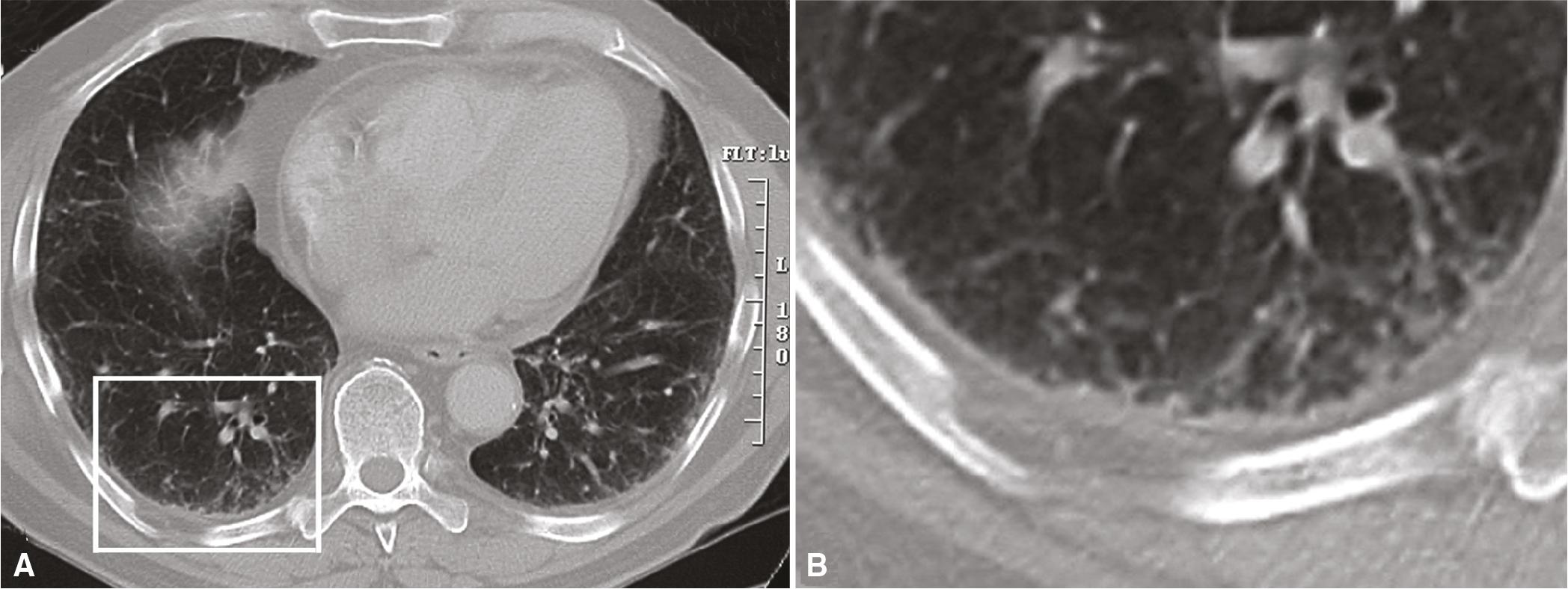
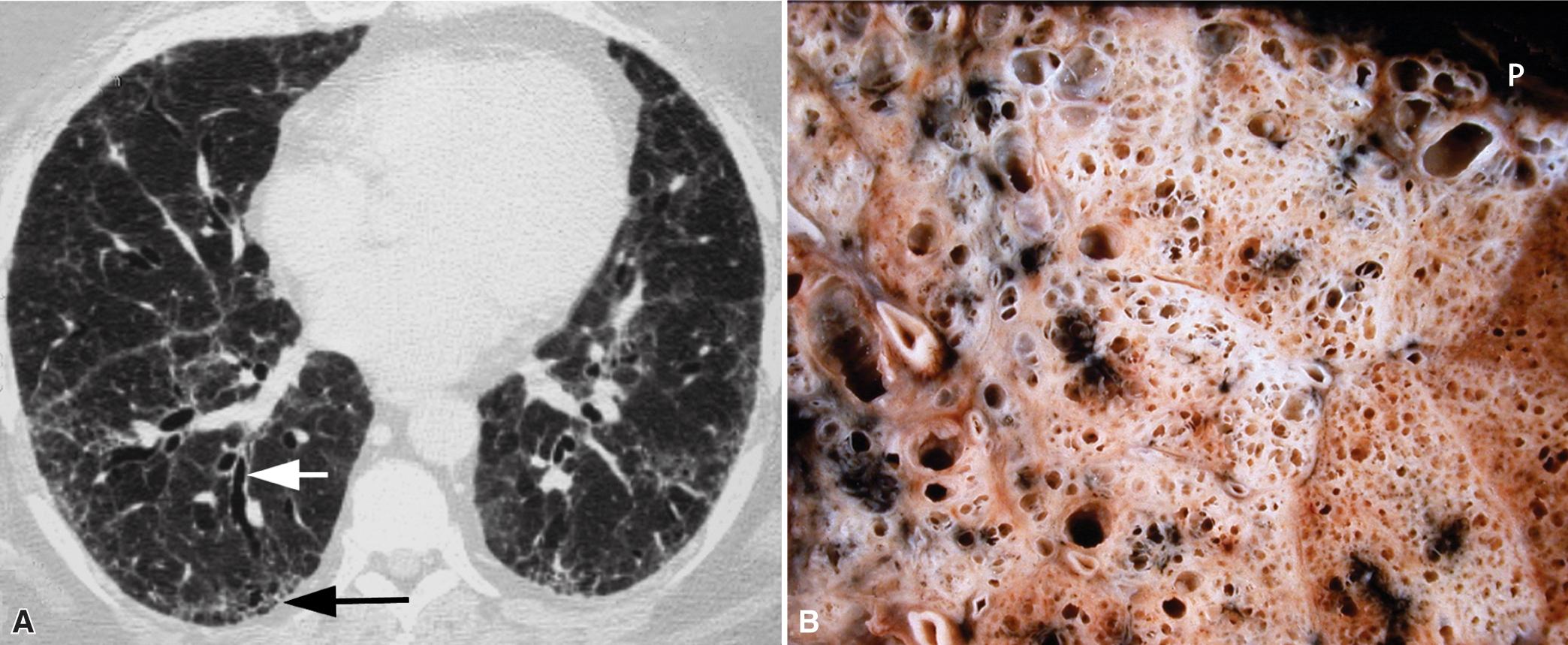
UIP cannot be diagnosed with traditional transbronchial biopsy specimens. Cryobiopsy is a recently developed technique that uses a cryoprobe to freeze and remove a larger tissue biopsy sample using a transbronchial approach. Initially, cryobiopsy was shown to be sufficient to make a diagnosis of UIP because of the larger sample size and lack of crush artifact associated with traditional biopsy forceps. However, two large trials in which cryobiopsy and surgical lung biopsy were performed on the same patient in the same anesthesia setting yielded conflicting results on the usefulness and concordance of cryobiopsy for ILD, including UIP. , The usefulness of cryobiopsy remains an area of active research. Surgically-derived wedge lung biopsies (3–5 cm in length by 2–3 cm in breadth) obtained from video-assisted thoracoscopic surgery or open thoracotomy are the most appropriate samples for diagnosis (see Chapter 3 for additional details on the lung biopsy). Occasionally UIP will be evident in lobectomy and pneumonectomy specimens obtained for other diseases. Because UIP is a process that involves more peripheral areas of the lung even ambitious tranbsronchial biopsy sampling is often unhelpful, as peripheral lung may not be included. Surgical biopsies should be taken from more than one site, and preferably a biopsy sample should be obtained from all lobes in the hemithorax chosen for surgical intervention. If only two areas can be sampled, midlung and lower lung are preferable to upper and midlung, and samples from the lower lobe should be taken above the most advanced areas of fibrosis.
The characteristic histopathologic findings of UIP have been referred to as being “temporally heterogeneous” or having a “patchwork quilt” appearance, concepts and terms that are often misunderstood by surgical pathologists and pulmonologists. An expanded description of temporal heterogeneity is that of transitions in the biopsy from dense scar (the “past”) to normal lung (the “future”—lung tissue yet to be involved). At the juncture of these, transitions occur through patches of active lung injury referred to as “fibroblast” or “fibroblastic” foci ( Fig. 8.3 ). These transitions are often abrupt in UIP of IPF, occurring in less than a single high-power field under the microscope. The remodeled lung is present mainly beneath the pleura and at the periphery of the secondary lobule, adjacent to interlobular septa ( Fig. 8.4 ). When UIP is recognizable as a distinct pathologic entity, the subpleural fibrosis contains smooth muscle proliferation in disorganized fascicles ( Fig. 8.5 ), and foci of microscopic honeycombing are evident, even when the overall process appears to be mild or early in its evolution ( Fig. 8.6 ). Microscopic honeycombing probably represents one of the early manifestations of the gross honeycomb cysts seen in the end stage of UIP. As used by radiologists, the term honeycombing refers to an array of much larger cysts (in the range of 0.5 to 3 cm or larger) as a localized manifestation of advanced lung remodeling ( Fig. 8.7 ). Microscopic honeycomb cysts are considerably smaller (in the range of 1–3 mm) and are typically present subpleurally ( Fig. 8.8 ). The cysts are lined by columnar ciliated epithelium and nearly always filled with mucus and variable amounts of acute inflammation or proteinaceous material that may mimic pulmonary alveolar proteinosis (PAP) ( Fig. 8.9 ). Microscopic honeycomb remodeling is not specific to UIP of IPF but rather represents the histologic manifestation of advanced fibrosis. As such, honeycomb remodeling can be seen in advanced fibrosis secondary to CVD and chronic hypersensitivity, among others. When dense chronic inflammation is present it is most often around microscopic honeycombing.
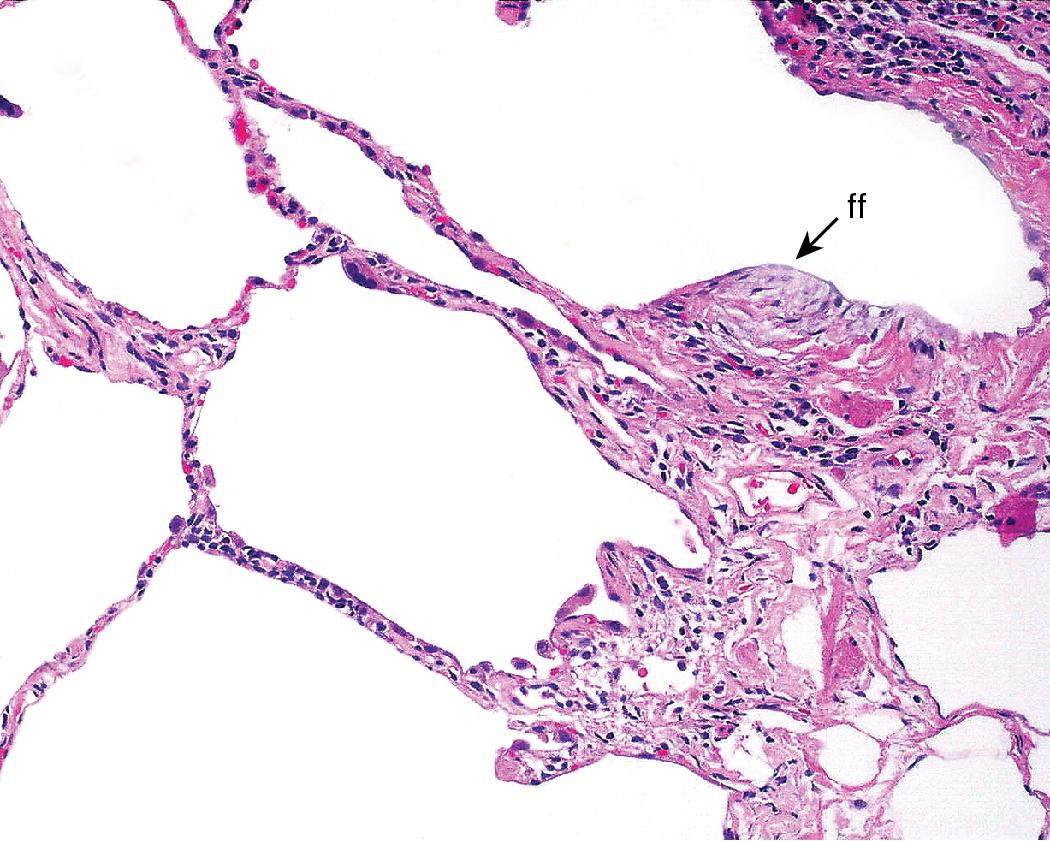
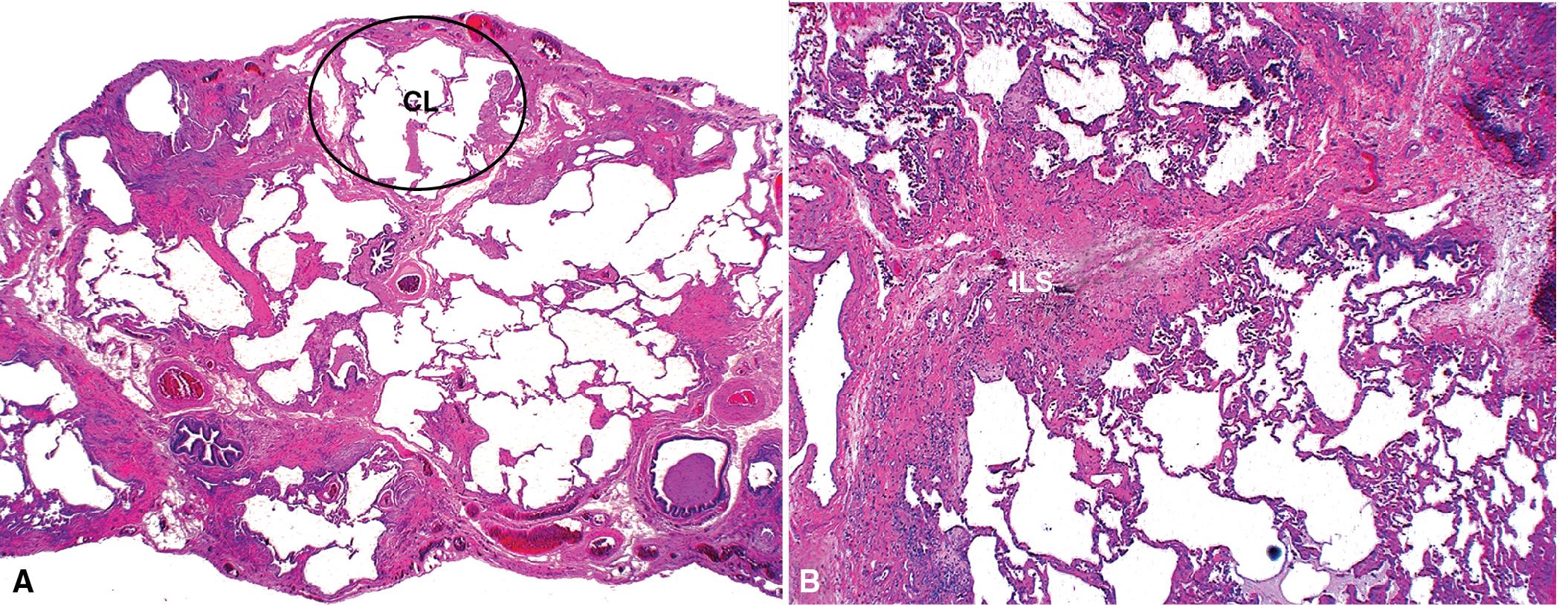
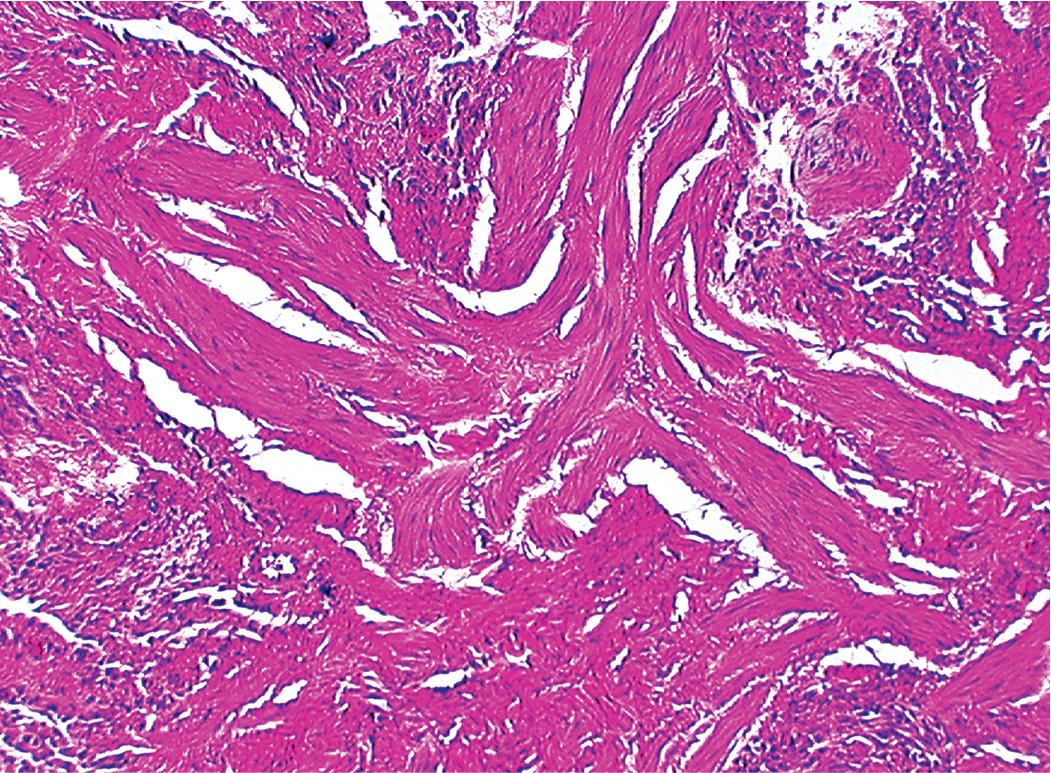
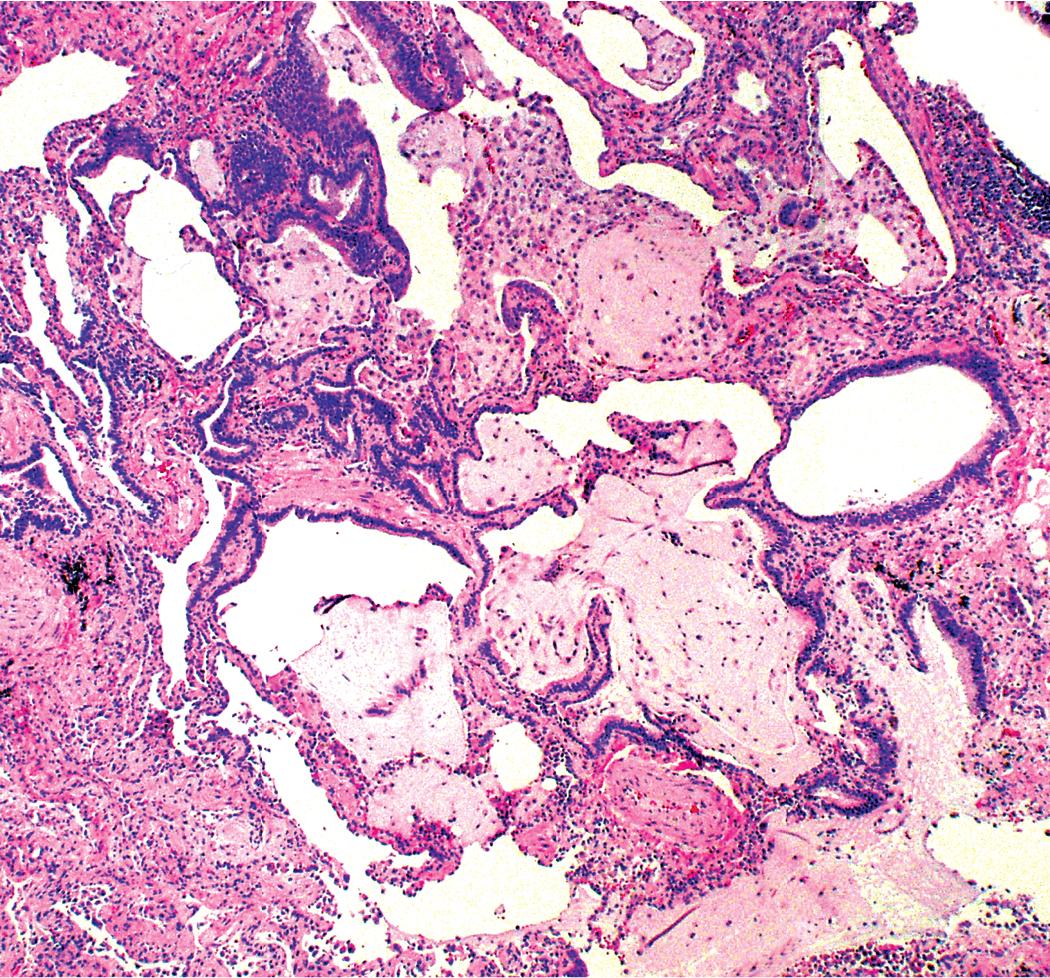
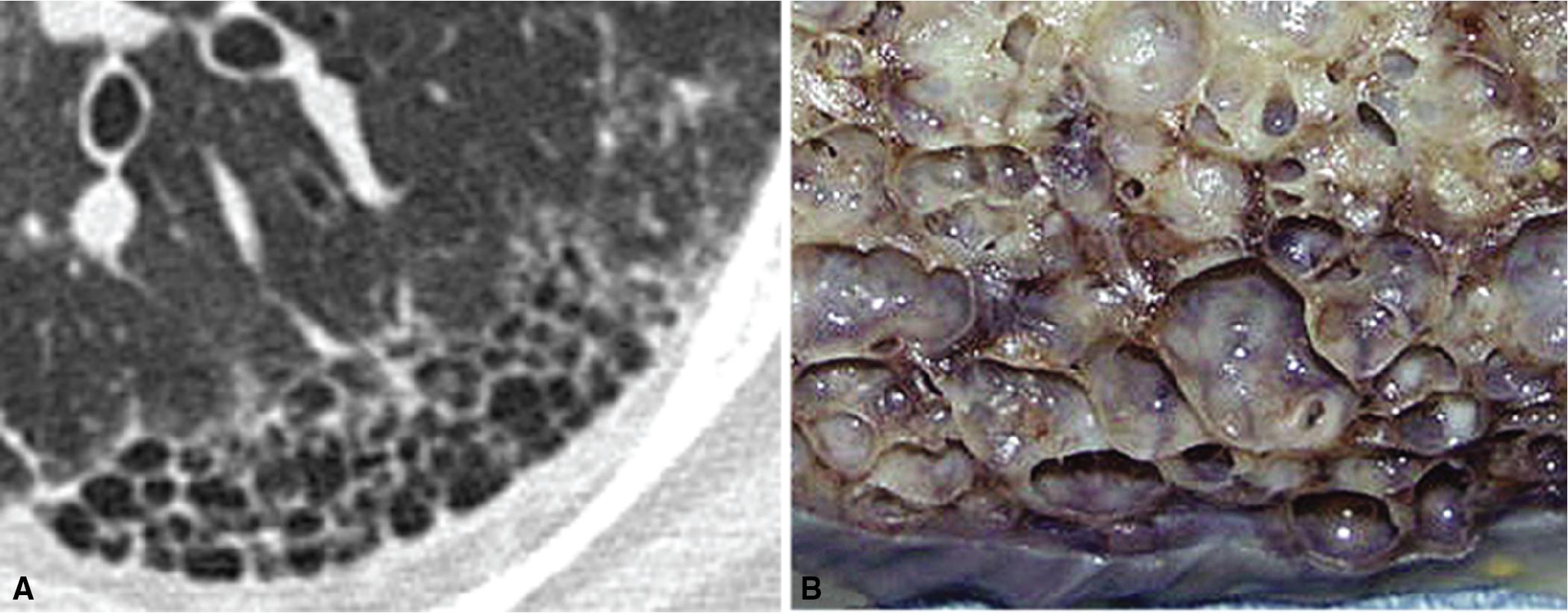
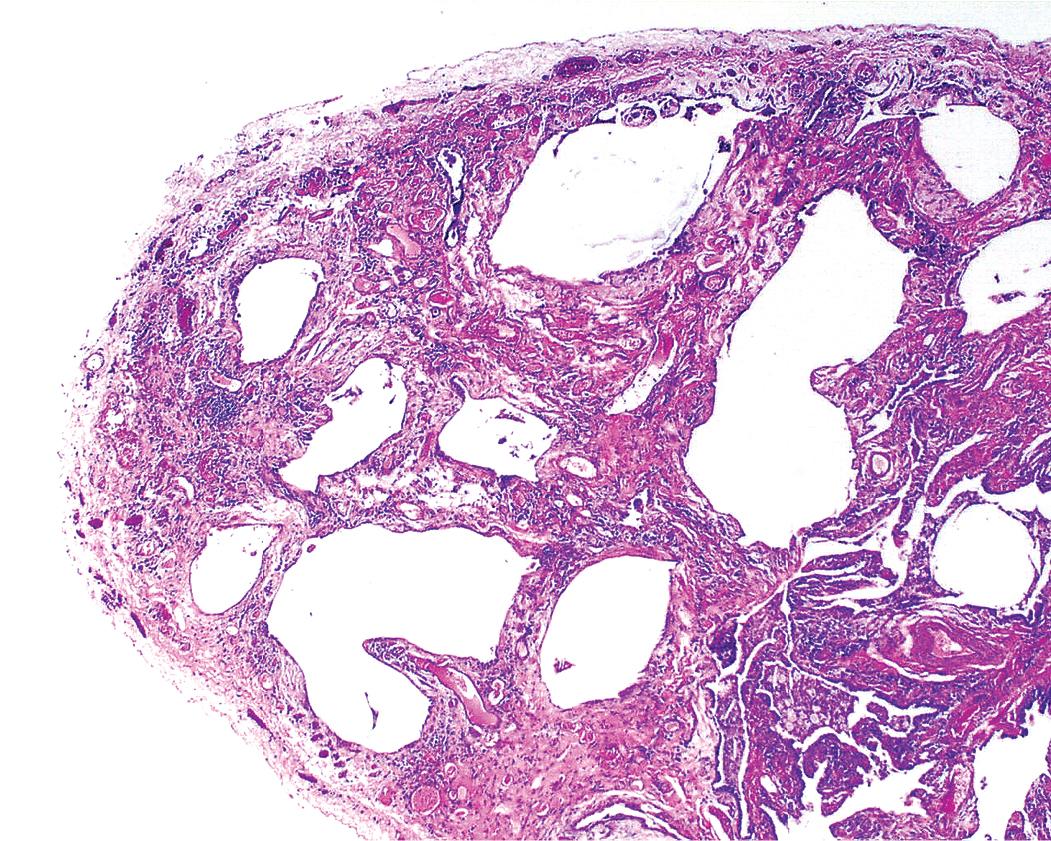
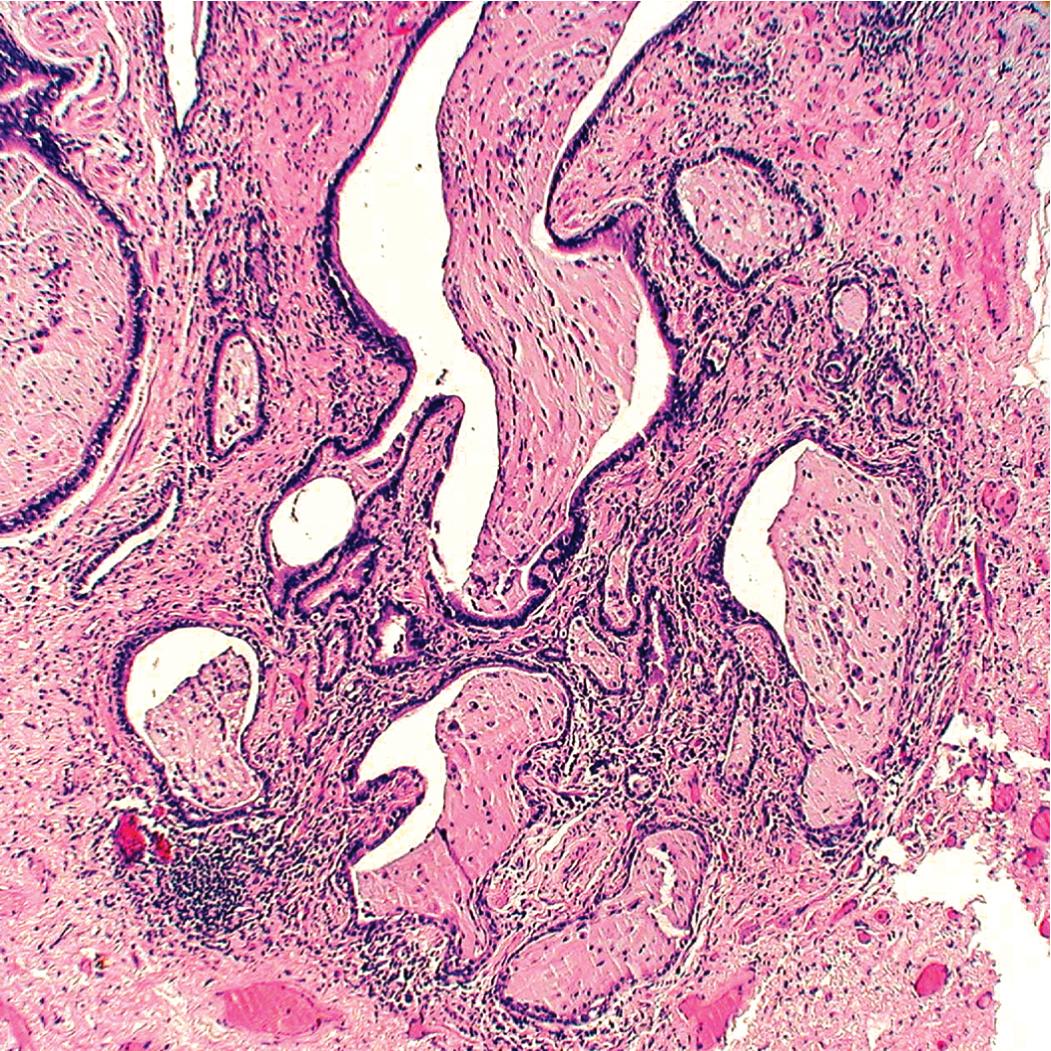
Exactly how honeycomb cysts (gross or microscopic) form is unclear, but we believe they represent centrilobular airways, trapped in the fibrous remodeling, that are then pulled to the periphery of the lobule. In support of this concept, lobules with foci of microscopic honeycombing often lack a visible central airway, and tractional emphysema is nearly always present. This hypothesis would also explain the presence of smooth muscle fascicles in subpleural fibrosis and may thus be more tenable than the hypothesis that such muscle forms by fibroblast metaplasia.
Between the two temporal extremes of “old” peripheral fibrosis and uninvolved lung present centrally in the lobule is the presumed active zone of injury in UIP, evidenced by a crescent-shaped bulge of immature fibroblasts (technically, myofibroblasts ) and ground substance (see Fig. 8.3 ). This lesion is known as the fibroblastic focus and typically is not extensive in the biopsy. Fibroblast foci have been shown to be continuous linear structures in three-dimensional reconstruction. Some investigators have postulated that the increased number of these foci in a given UIP patient’s biopsy is associated with a worse prognosis, and that a relative lack of fibroblastic foci may be an explanation for the better prognosis observed for patients with UIP-like lung fibrosis related to systemic CVDs.
UIP is not an overtly inflammatory condition in the absence of so-called acute exacerbation (see further on). This is not to imply that fibrosis occurs “mysteriously” in the disease. Some form of injury is occurring in UIP, but it seems to be subtle and is probably directed at the alveolar epithelium and its underlying basement membrane (epithelial-mesenchymal transitions). The fibroblastic foci of UIP appear immediately beneath reactive-appearing alveolar lining epithelium, where they obscure the epithelial basement membrane and bulge into the adjacent airspace ( Fig. 8.10 ), as though they were aborted Masson polyps of the type seen in organizing pneumonia (OP) (see later under Cryptogenic Organizing Pneumonia). Further evidence of an injury repair phenotype for UIP/IPF is the consistent presence of reactive type II cell proliferation overlying fibroblastic foci. Conceptually, the subtle inflammatory disease of UIP burns like a smoldering fire through the lung, leaving fibrosis, smooth muscle proliferation, microscopic honeycombing, and fibrosis in its path.
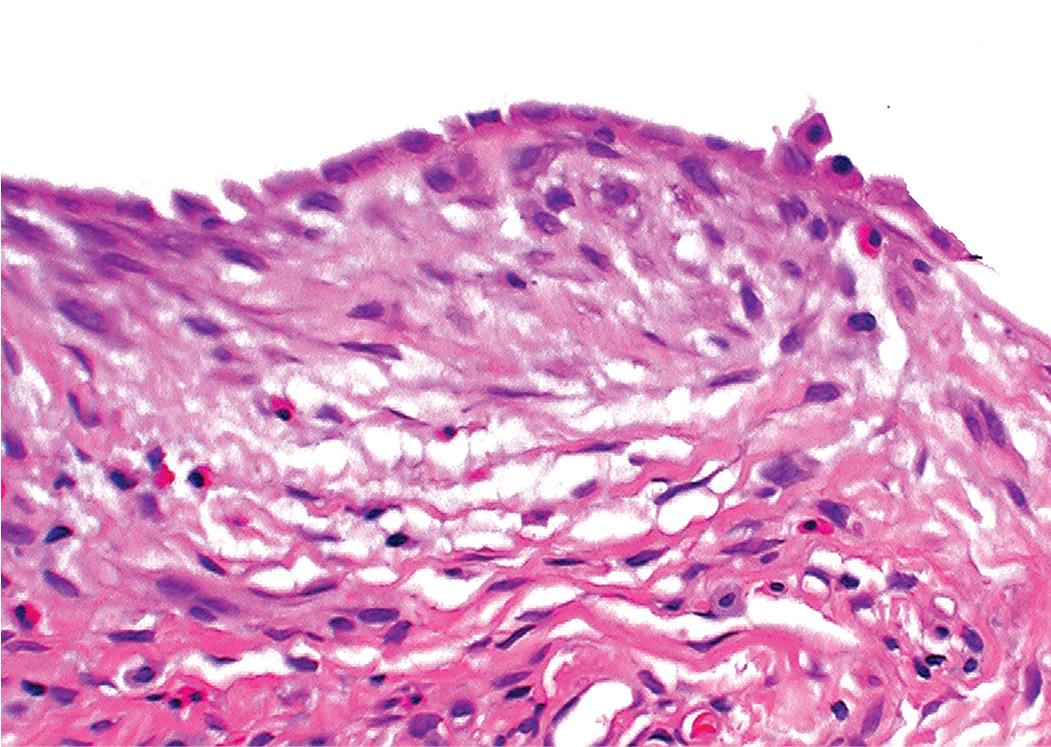
The ATS/ERS/JRS/ALAT recommends classifying histologic lung biopsies with fibrosis into four categories based on the likelihood of a UIP designation: UIP, probable UIP, indeterminate for UIP, and alternative diagnosis. , The UIP pattern must show all of the following: (1) dense fibrosis with architectural distortion, (2) predominant subpleural and/or paraseptal distribution of fibrosis, (3) patchy involvement of lung parenchyma by fibrosis, (4) fibroblast foci, (5) absence of features to suggest an alternate diagnosis. Probable UIP also shows marked fibrosis with or without honeycombing, absence of either patchy involvement of fibroblast foci but not both, and the absence of features arguing against a diagnosis of UIP. Biopsies with honeycomb change alone are categorized as probable UIP. Indeterminate for UIP shows fibrosis with or without architectural distortion, with features favoring either a pattern other than UIP or features favoring UIP secondary to another cause. Indeterminate for UIP may also show some of the definitive features of UIP, but may also shows features of an alternative diagnosis. These features may include hyaline membranes, OP, granulomas, marked interstitial inflammation away from honeycombing, lymphoid hyperplasia, and predominant airway-centered changes. Biopsies in the alternative diagnosis category show definitive features of a diffuse parenchymal lung disease other than UIP. Some of the challenges associated with the implementation of these criteria in clinical practice are the lack of well-defined criteria as to the quantity of granulomas, giant cells, interstitial inflammation, or airway-centered changes that may be sufficient to trigger a non-UIP-pattern designation. , In addition, patients with IPF in acute exacerbation (see further on) often show hyaline membranes and OP. Nevertheless, pathologists should be aware of the existence of these criteria and should use caution in using the term UIP pattern in their reports unless they are confident that the biopsy is consistent with IPF.
In his writings, Liebow conceived of UIP as a chronic lung disease resulting from repeated subclinical episodes of “diffuse alveolar damage” (DAD). In support of this hypothesis, episodic deterioration is typical in patients with IPF. In some patients with IPF, however, clinical deterioration is abrupt and overwhelming. Many of these acute deteriorations are of unidentifiable cause and have been referred to as acute exacerbations of IPF . Acute exacerbations have been the subject of considerable laboratory investigation, but the mechanism of their occurrence remains unknown. We do know that when such episodes are biopsied, the most consistent pathologic finding is that of DAD. Acute exacerbations of IPF can manifest as other patterns of acute lung injury, such as OP, but they may rarely show increased numbers of fibroblastic foci as a lone pathology. Despite the implication of the term, the “acute” exacerbation tends to evolve over several weeks rather than a few days. The mixed histopathologic changes can be confusing to the surgical pathologist (and to the radiologist) examining the lung biopsy because the background older fibrosis with microscopic honeycombing of UIP is often overshadowed by diffuse acute lung injury ( Fig. 8.11 ).

The three patients described by Kondoh and coworkers all showed some degree of improvement in the short term after high-dose corticosteroid therapy, but no consistently effective therapy has emerged. Several investigators have proposed that acute exacerbations may be the common terminal episode in many patients with IPF even though respiratory failure has always been presumed to be of slower evolution. Based on all available data, including data from the placebo arms of several large randomized, double-blind, placebo-controlled trials in patients with IPF, an estimated 10% to 15% of patients with UIP experience overwhelming acute exacerbation during the course of their disease, and this is often the fatal event for those affected. ,
A number of diseases can cause heterogeneous pulmonary fibrosis reminiscent of the UIP pattern. When the biopsy shows heterogeneous fibrosis and there is radiographic evidence of a diffuse bilateral process, the main entities in the differential diagnosis are listed in Box 8.5 . If the biopsy meets the strict criteria of a UIP pattern as described by the ATS/ERS/JRS/ALAT , (see earlier), the differential diagnosis is significantly shortened to IPF, CVD, chronic hypersensitivity pneumonitis, and pneumoconioses. A practical approach to the differential diagnosis of biopsies showing advanced fibrosis is provided at the beginning of this chapter. The final diagnosis often requires clinical exclusion of the other possibilities and multidisciplinary discussion. , There are cases showing coexistence of histopathologic patterns of NSIP and UIP in the same patient in multiple lobe biopsies. Such cases can be considered discordant UIP. However, the clinical course of discordant UIP is still more like that of nondiscordant UIP, with possibly longer survival. The 2013 classification of IIPs suggests the use of “unclassifiable IIPs” for the cases showing multiple histologic patterns.
Usual interstitial pneumonia (UIP)
Desquamative interstitial pneumonia (DIP)
Lymphoid interstitial pneumonia (LIP)
Systemic collagen vascular disease
Certain chronic drug reactions
Pneumoconioses
Sarcoidosis
Pulmonary Langerhans cell histiocytosis (pulmonary histiocytosis X)
Chronic granulomatous infections
Chronic aspiration
Chronic hypersensitivity pneumonitis
Organized chronic eosinophilic pneumonia
Healed diffuse alveolar damage
Chronic interstitial pulmonary edema/passive congestion
Radiation exposure (chronic)
Healed infectious pneumonias and other inflammatory processes
Nonspecific interstitial pneumonia (NSIP)
Hermansky-Pudlak syndrome (oculocutaneous albinism with platelet dysfunction)
Idiopathic pulmonary fibroelastosis
Idiopathic airway-centered fibrosis
Erdheim-Chester disease (non–Langerhans cell histiocytosis)
The most common causes of death among patients with IPF are listed in Box 8.6 . As defined clinically, IPF patients have a median survival time of less than 3 years. The use of CVD immunosuppression treatment regimens in patients with IPF has been shown to speed the time to death or hospitalization, underscoring the importance of accurate diagnosis and classification. To date, no trial has revealed a successful cure for the disease. However, antifibrotic agents, such as pirfenidone, have been shown to slow functional loss in IPF patients and have become the mainstay of treatment. Success with antifibrotic agents in the realm of IPF have spurned on clinical trials in other progressive pulmonary fibrosis phenotypes. It is important to note that this “new” category of disease (progressive pulmonary fibrosis phenotype) does not represent a single clinicopathologic/etiologic entity but rather a group of fibrosing lung diseases that are progressive. While antifibrotic agents may be effective in slowing the rate of decline of forced vital capacity in this diverse group of diseases, antifibrotics are not targeting the underlying pathophysiologic mechanism of lung injury and scarring. The field must continue investigations into novel therapies aimed at the underlying etiology of the lung injury.
Respiratory failure, 38.7%
Infection, 6.5%
Lung cancer, 10.4%
Pulmonary embolism, 3.4%
Heart failure, 14.4%
Ischemic heart disease, 9.5%
Other, 17.1% a
Of the 543 patients in the study, 60% died in the follow-up period, which ranged from 1 to 7 years.
a Including pneumothorax, corticosteroid-induced metabolic side effects and myopathy, and therapy-related immunosuppression.
For pulmonary physicians, a pathologic diagnosis of UIP implies clinical IPF; accordingly, pathologists should use great caution in making a diagnosis of UIP in the absence of clinical and radiologic correlation. The gravity of the prognosis and the divergent treatments strongly support this notion. If the pathologic findings are compelling for a UIP pattern, it is reasonable to use a descriptive diagnosis such as that presented in Box 8.7 . This approach provides an opportunity for further correlation by clinical colleagues and radiologists in solidifying the diagnosis.
Usual Interstitial Pneumonia (see comment).
Comments: The histopathologic changes are seen most often in the setting of idiopathic pulmonary fibrosis. Clinical exclusion of chronic hypersensitivity pneumonitis, connective tissue disease, and pneumoconioses is required for a definitive diagnosis of idiopathic pulmonary fibrosis.
Fibrosing interstitial pneumonia with microscopic honeycombing and lymphoid follicles with germinal centers (see comment).
Comment: The histologic changes in this biopsy are reminiscent of the UIP pattern of pulmonary fibrosis typically seen in patients with clinical idiopathic pulmonary fibrosis. However, the presence of lymphoid follicles with germinal centers may indicate a possibility of connective tissue disease. Exclusion of connective tissue disease with complete serologic screening studies is suggested.
Histopathologic Criteria for UIP
Chronic fibrosing interstitial pneumonia with
Significant fibrosis/architectural distortion
Mostly subpleural/paraseptal distribution
Patchy involvement
Honeycomb change
Centrilobular sparing
Fibroblastic foci are present at the junction of fibrosis with normal lung
Sharp demarcation between advanced fibrosis and normal lung
UIP biopsies should NOT show any of the following:
Nonspecific interstitial pneumonia-like areas
Centrilobular scarring
Granulomas or giant cells
Hyaline membranes or organizing pneumonia (unless in acute exacerbation)
Pleuritis
Lymphoid hyperplasia with secondary follicles
There is a small subset of patients with IPF who have a history of unexplained lung disease in first-degree relatives. This form of pulmonary fibrosis has been referred to as familial IPF or familial interstitial pneumonia (although in most studies of familial interstitial pneumonia, fibrosis seems to be the dominant pattern of disease). A compelling body of evidence suggests that IPF has a genetic component, , and its familial occurrence is not surprising. Steele and colleagues examined the population of persons with familial interstitial pneumonia from 111 candidate families and found that more than 80% of these individuals had clinical IPF, followed by NSIP. Genetic analysis was performed in search of the mechanism underlying familial IPF, and telomerase germline mutations were identified in 8%. The role of telomerase mutations was hypothesized to be a function of excess telomere shortening over time, resulting in cellular dysfunction and premature cell death.
For many years after Liebow’s classification of IIPs was widely adopted, a number of diffuse inflammatory lung diseases were identified that did not fit well within this classification scheme. Various terms were applied to such diffuse lung diseases, including “chronic cellular” and “unclassifiable” interstitial pneumonia. In 1994 the term NSIP was proposed by Katzenstein and Fiorelli, based on data from 64 patients who presented with diffuse lung disease and a chief complaint of dyspnea, usually present for several months before evaluation. Radiologic studies showed bilateral interstitial infiltrates with variable consolidation. Importantly, the 64 patients in this study had a significantly better prognosis than that observed for patients with UIP.
Katzenstein and Fiorelli recognized that the constellation of histopathologic patterns seen in NSIP did not represent one disease and, in follow-up investigations, found that these patients often had hypersensitivity, resolving infection, or systemic CVD, among other occurrences. Nagai and coworkers studied a group of patients with cellular interstitial pneumonia and rigorously excluded possible etiologies. The reported survival rate in this “idiopathic NSIP” was 90% at 5 years. Thus when used in the true idiopathic context, the designation NSIP may actually be useful if it consistently implies an interstitial chronic inflammatory disease of unknown etiology with an expected good response to therapy and excellent survival rate. If, on the other hand, the term is applied indiscriminately as a substitute for any histopathologically unrecognized ILD, clinical behavior will be impossible to predict, thereby significantly reducing the benefit of lung biopsy.
Some general statements can be made regarding the clinical presentation in NSIP, recognizing that most of the available data have been derived from studies in which a heterogeneous group of disorders were represented. Patients with NSIP histopathology in lung biopsies (i.e., an NSIP pattern) tend to be younger than patients with UIP ; the NSIP pattern might also appear in children. As with many of the chronic diffuse lung diseases, symptoms develop gradually. Shortness of breath, cough, fatigue, and weight loss are the most common complaints. Fever and digital clubbing have been reported but are uncommon. ,
As in UIP, most of the chest x-ray abnormalities in NSIP are confined to the lower lung zones and tend to be bilateral and symmetrical. Less than 40% of the lung volume is typically involved. Patchy parenchymal (alveolar) opacification is a commonly reported abnormality, but reticular (interstitial) changes have also been identified. High-resolution CT findings are variable and nonspecific. The most common findings are a reticular pattern and traction bronchiectasis, followed by lobar volume loss and ground-glass attenuation. As uncommon features, subpleural sparing, irregular linear opacities, patchy honeycombing, and nodular opacities can be seen. , As might be anticipated, some of the findings described for NSIP overlap with those in other ILDs, such as hypersensitivity pneumonitis and cryptogenic organizing pneumonia (COP). At the stage before honeycomb cysts are visible, even UIP can be indistinguishable from certain forms of fibrotic NSIP.
Katzenstein and Fiorelli emphasized that the histopathologic pattern in NSIP was temporally uniform ( Fig. 8.12 ), in contrast with the UIP pattern, in which variable zones of established (dense) fibrosis, more active fibroplasia, and normal lung all coexist in the same biopsy specimen (i.e., temporal heterogeneity). As initially defined, the inflammatory process in NSIP is diffuse and uniform, mainly involving the alveolar walls ( Fig. 8.13 ) and variably affecting the bronchovascular sheaths ( Fig. 8.14 ) and pleura ( Fig. 8.15 ). In some patients infiltrates are predominantly peribronchial, whereas in others germinal centers may be seen along with chronic pleuritis. When airspace organization (the OP pattern) is present, it is not uniformly distributed ( Fig. 8.16 ), as might occur in organizing infectious pneumonia. When fibrosis occurs in NSIP, it is usually mild and preserves lung structure ( Fig. 8.17 ). Peribronchiolar metaplasia of variable extent may be seen, but microscopic honeycombing is characteristically absent. ,
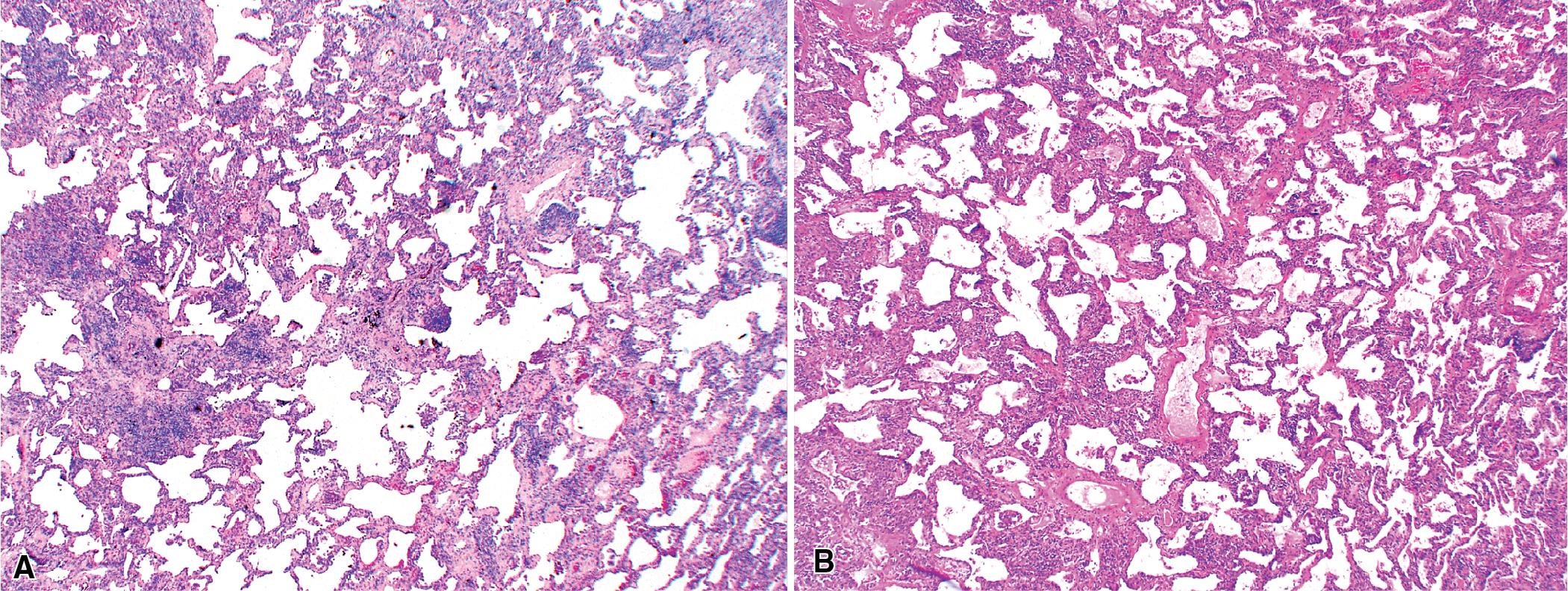
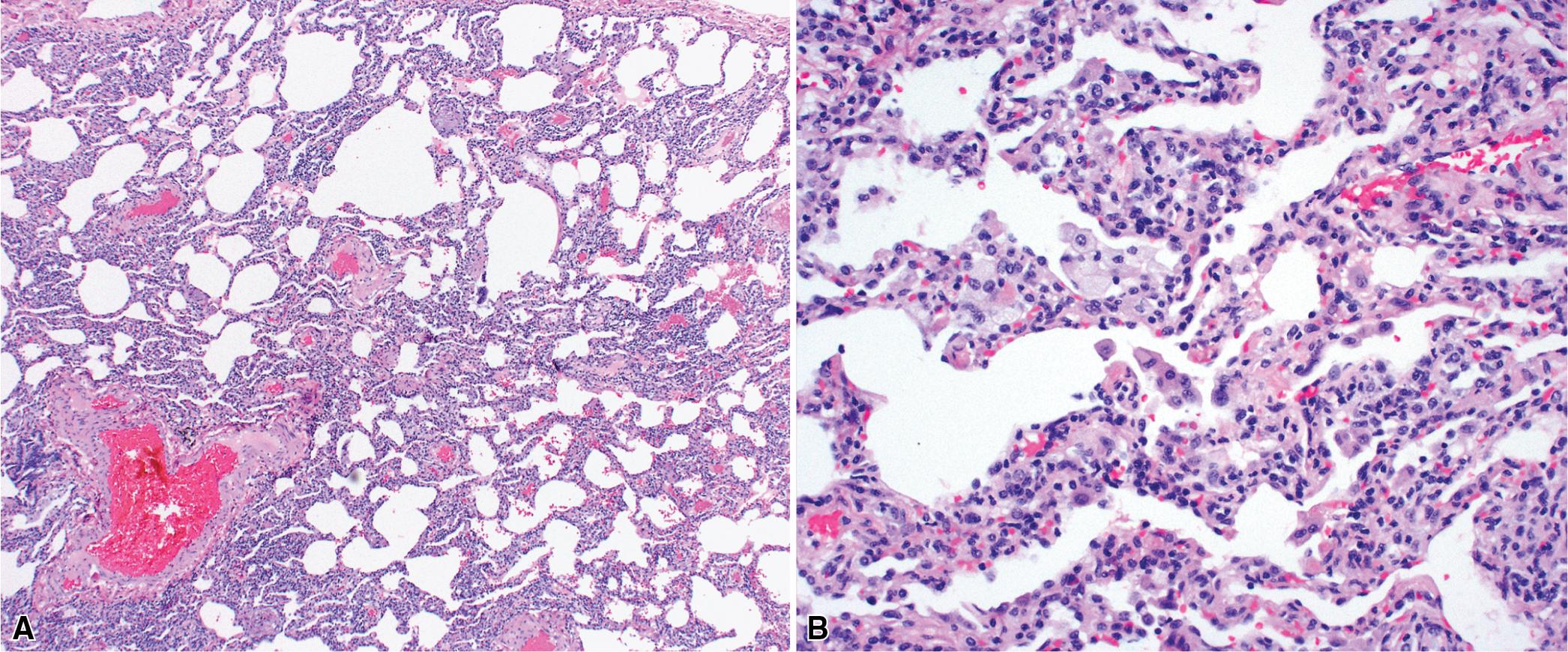
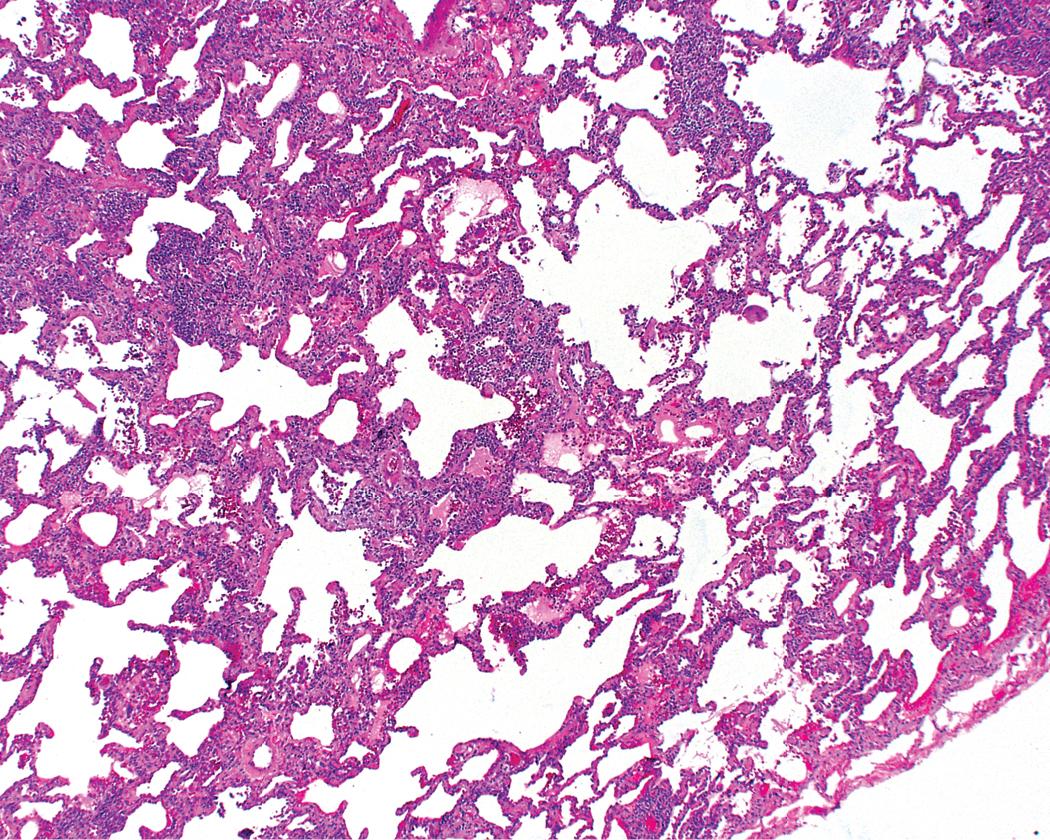
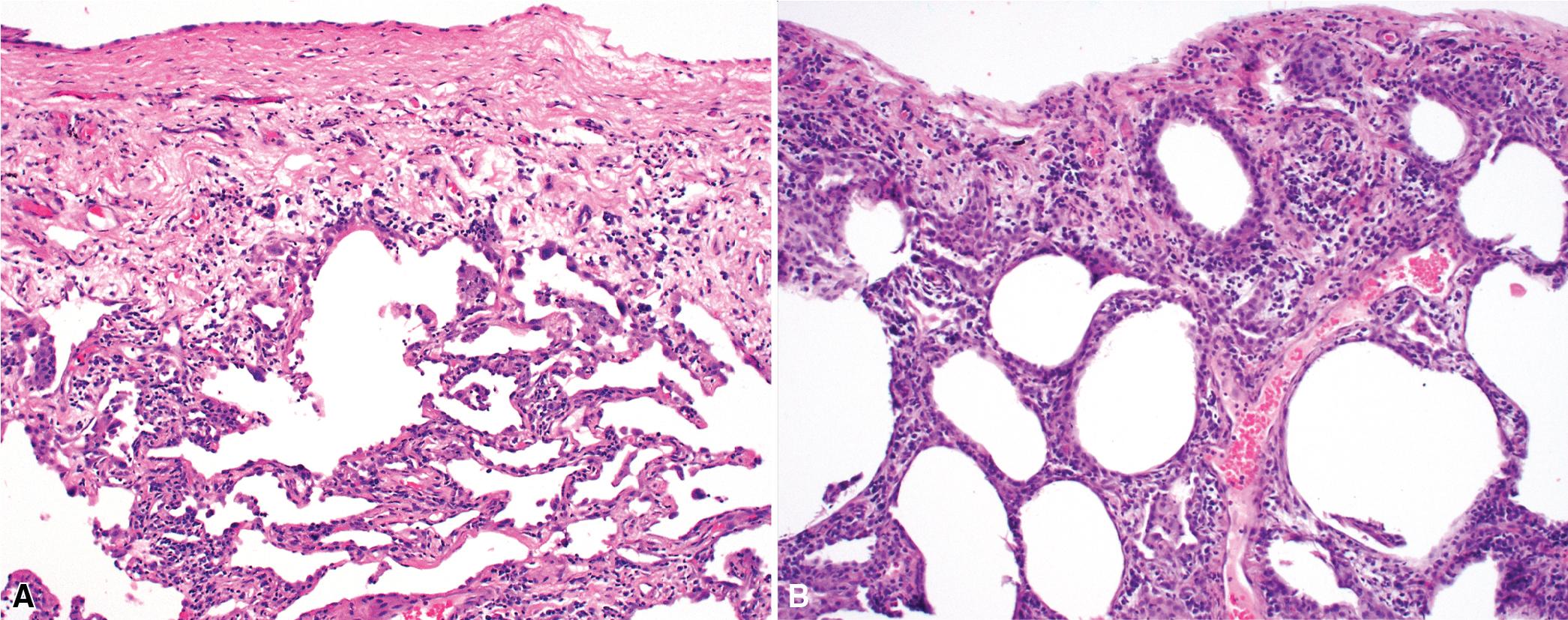
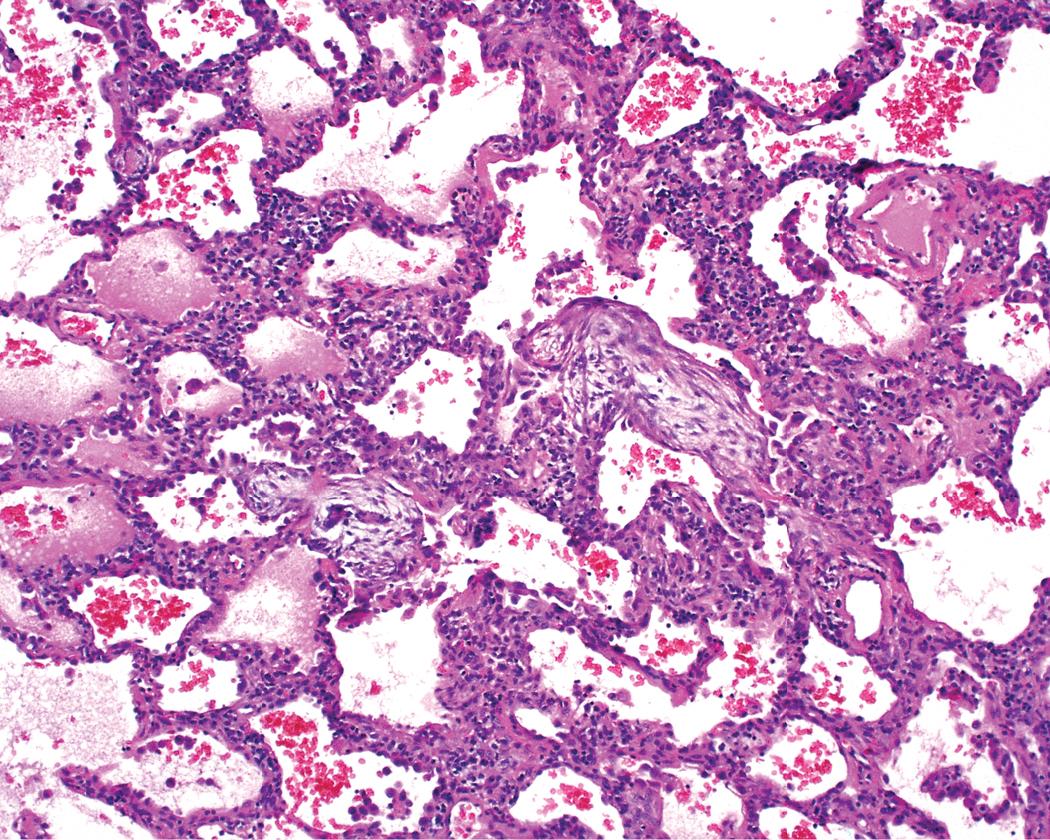
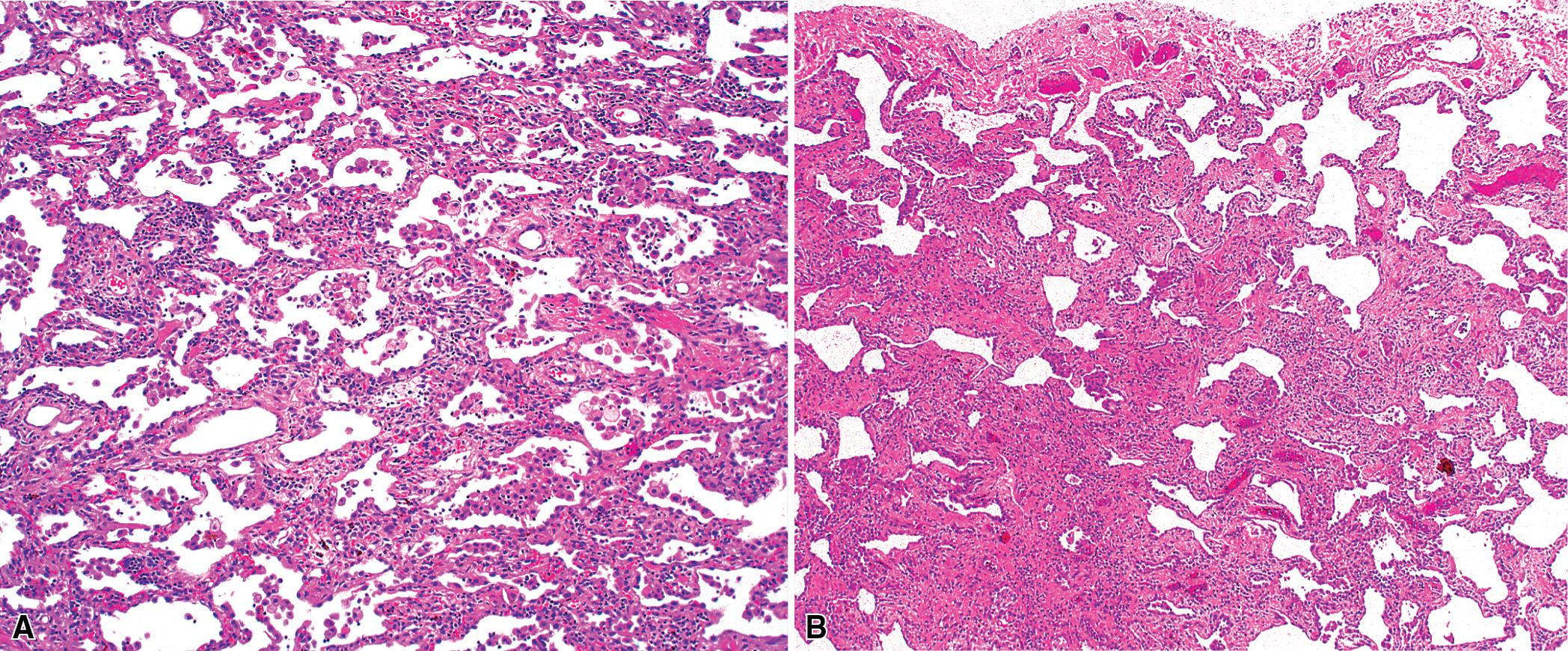
Historically, there has been debate as to whether NSIP is a new interstitial lung disease or simply a wastebasket category of diseases with some overlapping features. The most recent classification of IIPs includes idiopathic NSIP as a major IIP. However, caution is advised in using this term for all lung disease with interstitial inflammation, just as it is imprudent to diagnose all fibrosing lung diseases as UIP.
The main entities in the differential diagnosis of the NSIP pattern include hypersensitivity pneumonitis, systemic CVDs manifesting in the lung, resolving infection, and low-grade lymphoproliferative disease masquerading as LIP (see later). A practical approach to the cellular interstitial infiltrates is provided at the end of this chapter. Cellular NSIP and LIP may be difficult to distinguish from one another on histopathologic grounds; therefore once lymphoproliferative disease has been rigorously excluded, they might be considered synonymous from the pathologist’s perspective. Kinder and associates hypothesized that a majority of NSIP cases fall into the category of undifferentiated CTD manifesting in the lung. Because of significant overlap between NSIP and ILD in CVD, careful follow-up with serologic testing is recommended. , NSIP is one of the major histologic patterns included in the criteria for the newly introduced term interstitial pneumonia with autoimmune features (IPAF). Details of IPAF are described later in this chapter. In clinical practice, in view of the limited arsenal of available therapies for ILD, managing NSIP as a systemic autoimmune disorder with immunosuppressive strategies (even though it may not be initially diagnosable by a rheumatologist) often proves to be the best course of action for the patient.
The overall survival rate for patients with NSIP is estimated to be in the range of 82.3% at 5 years and 73.2% at 10 years. The purely “cellular” form of NSIP seems to be a disease with a good prognosis compared with UIP and AIP.
When significant fibrous remodeling with microscopic honeycombing is permitted in the diagnosis of NSIP, 5- and 10-year survival rates change significantly for the worse. , This observation suggests that fibrotic forms of NSIP may be within the spectrum of other fibrosing lung diseases, such as UIP of IPF, and certain systemic CTDs that manifest in the lung with fibrosis.
Airspace organization is an extremely common manifestation of lung injury and can be seen after a wide variety of insults, from organizing lung infarction to bacterial pneumonia ( Box 8.8 ). For this reason, the OP pattern in the lung biopsy is the least specific and perhaps the most misunderstood.
Organizing infections
Organizing diffuse alveolar damage
Drug or toxic reactions
Collagen vascular diseases
Hypersensitivity pneumonitis
Chronic eosinophilic pneumonia
Airway diseases complicated by infection (bronchitis and emphysema, bronchiectasis, cystic fibrosis, aspiration pneumonia, and chronic bronchiolitis)
Airway obstruction
Peripheral reactive process surrounding pulmonary abscesses, infarcts, lesions of granulomatosis with polyangiitis, others
Cryptogenic organizing pneumonia
It is well known that lung repair following a wide spectrum of injuries frequently evolves through a phase of airspace organization. When organization is diffuse, involving the entire surgical biopsy, OP (or “diffuse airspace organization”) is an appropriate designation. When no etiology can be identified for an OP pattern, the clinical diagnosis of COP has been proposed (referred to previously as “idiopathic bronchiolitis obliterans organizing pneumonia”).
The term bronchiolitis obliterans organizing pneumonia (BOOP), as a distinct idiopathic disease, was first proposed by Davison and coworkers and later applied by Epler and colleagues to define a specific clinical disease course in a group of patients in whom lung biopsies showed variable amounts of airspace organization (OP pattern) of unexplained etiology. The importance of recognizing the pattern of OP in the clinical context that has been defined relates to therapy and prognosis. Patients with clinical COP respond well to systemic corticosteroid administration, and pulmonologists expect a good prognosis when this diagnosis is implied histopathologically. When BOOP is used in a pathology report as a descriptive term for the occurrence of OP in a biopsy, the clinician may misinterpret this to mean that idiopathic BOOP is the correct diagnosis. For example, the BOOP pattern may be seen in a disease with abundant background lung fibrosis. In this setting, the prognosis is best considered to be guarded.
As described by Epler and coworkers for the original idiopathic BOOP, the patient typically presents several weeks after an episode of clinical symptoms suggesting upper respiratory tract infection. The mean age at onset is 55 years, and a majority of patients are nonsmokers. , Slowly worsening symptoms of cough (sometimes productive) and dyspnea are typically present, often leading to surgical lung biopsy within 3 months of disease onset. Weight loss, night sweats, chills, intermittent fever, and myalgias are common. Upon study, mild to moderate restrictive pulmonary function is identified in a majority of patients. Hemoptysis and wheezing are typically absent. Often there is a marked increase in the ESR. Digital clubbing is not a feature of the disease.
Chest radiography and CT show a number of abnormalities, none of which are specific for one disease. Patchy airspace consolidation (loss of visible structure underlying opacification) is the most consistent finding and is present in 90% of cases. , Air bronchograms can be seen in areas of consolidation. Ground-glass attenuation accompanies consolidation in more than half of patients. The disease involves the lower more often than the upper lung zones. Small nodular opacities can be seen in 10% to 50% of patients.
In a small percentage of patients, large nodules may be seen; rarely, reticulonodular infiltrates occur. It is speculated that the latter finding identifies a subset of COP that may not respond to therapy. Opacities may be recurrent and/or migratory. , Lung volumes are normal in most patients, and pleural effusions rarely occur. , ,
The OP pattern is characterized by variably dense airspace aggregates of fibroblasts in ground substance (immature collagen matrix) ( Fig. 8.18 ). This alveolar filling process can be seen to extend into or from terminal bronchioles ( Fig. 8.19 ). Typically the lung architecture is preserved in COP, and lymphocytes, plasma cells, and histiocytes are present in variable numbers within the interstitium ( Fig. 8.20 ). , , Fibrin may be seen focally in association with airspace organization ( Fig. 8.21 ). The presence of prominent intraalveolar fibrin may be associated with increased risk of relapse of COP. Alveolar macrophage accumulation may be present, attesting to some degree of airway obstruction. , , When airspace organization is confluent and diffuse in the biopsy, COP is less likely to be the accurate diagnosis. Interstitial fibrosis and honeycomb lung remodeling are not components of the cryptogenic (idiopathic) form of OP. , , Rarely, airspace organization may ossify and produced “racemose” or “dendriform” ossification ( Fig. 8.22 ). When the polyps of OP undergo dense collagenization, the disease is referred to as cicatricial or fibrosing organizing pneumonia ( Fig. 8.23 A and B).
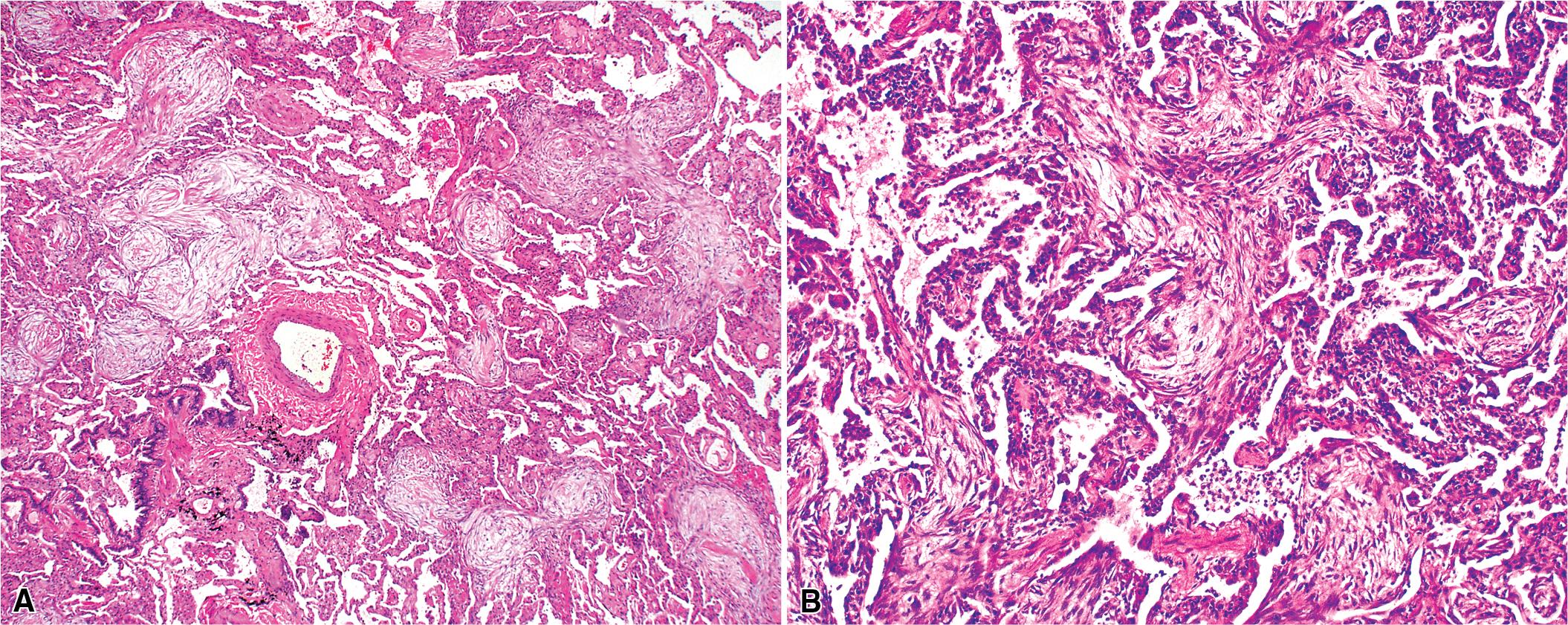
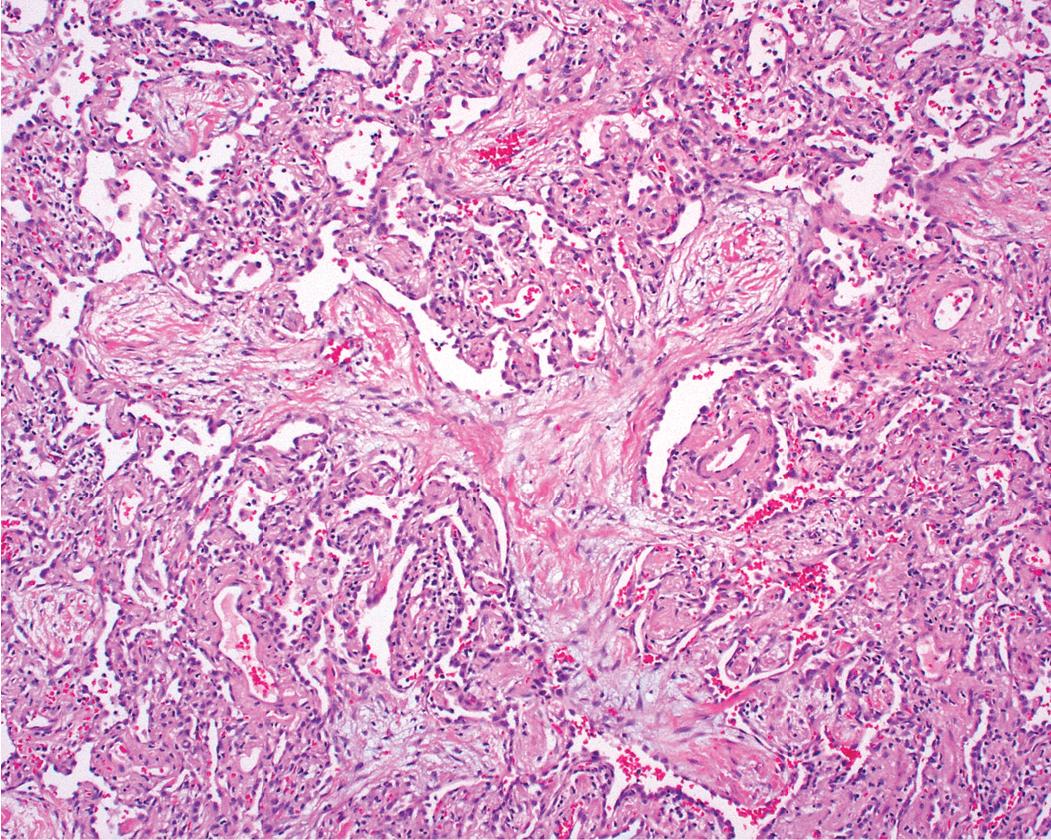
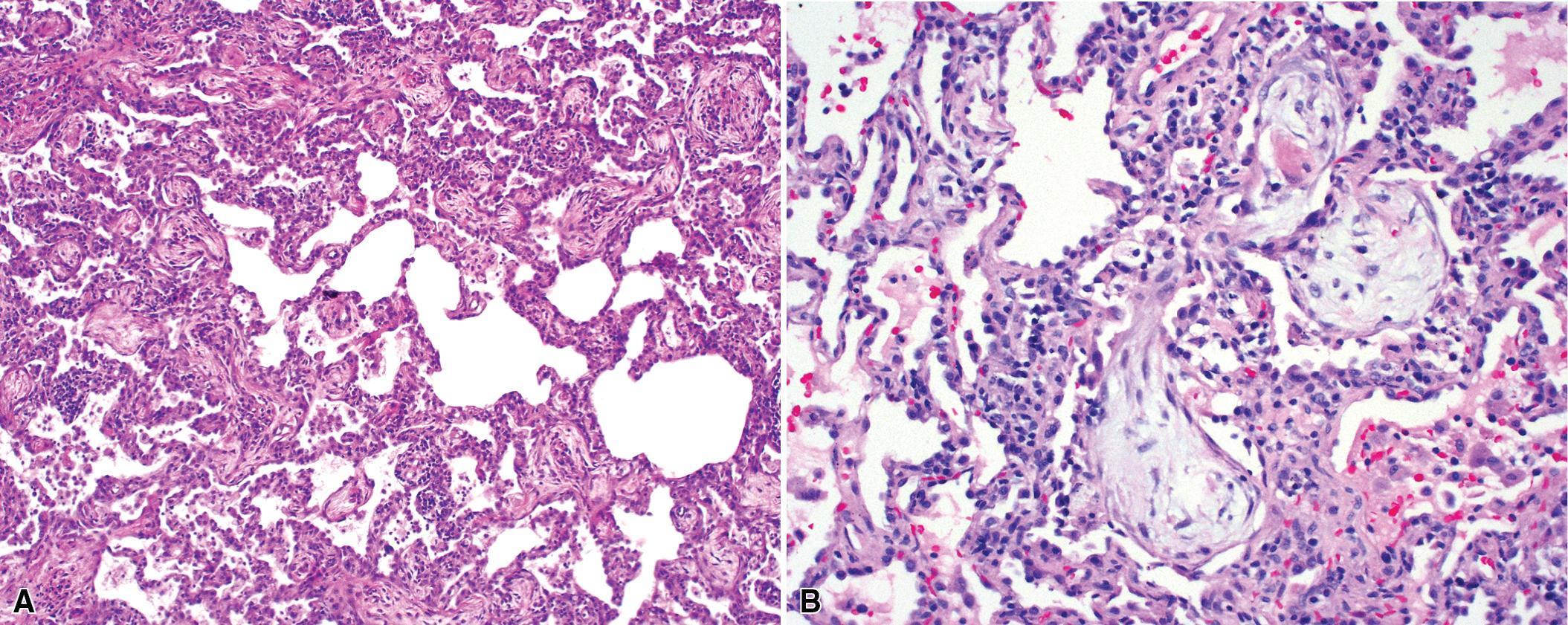
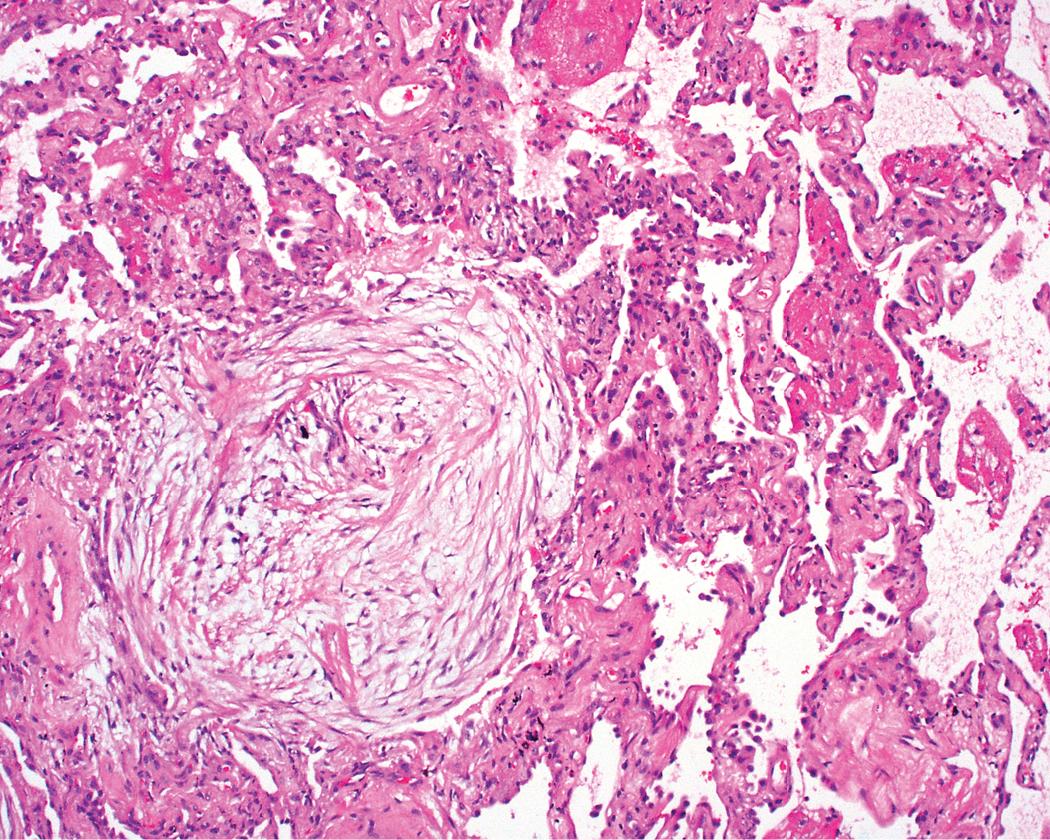
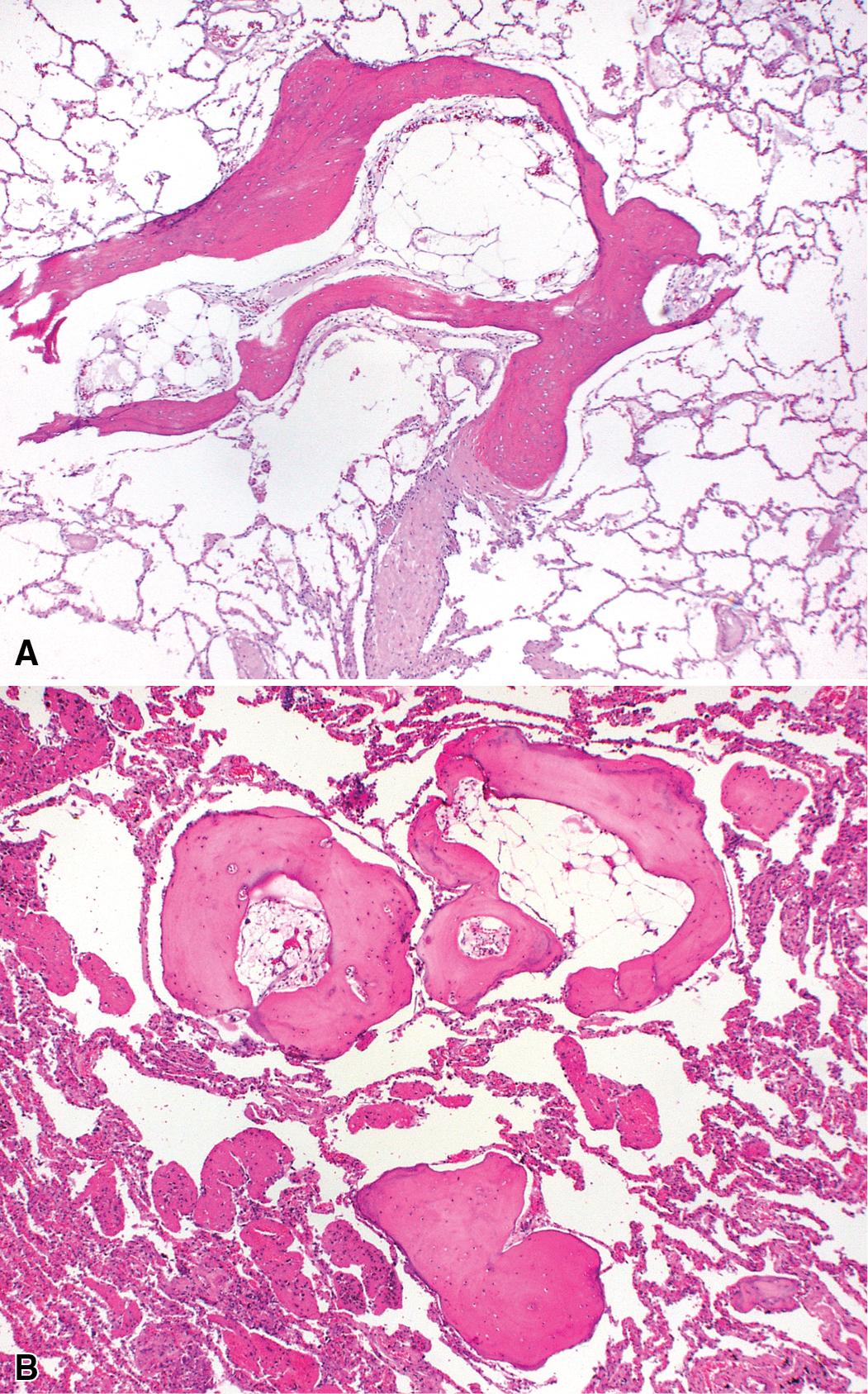
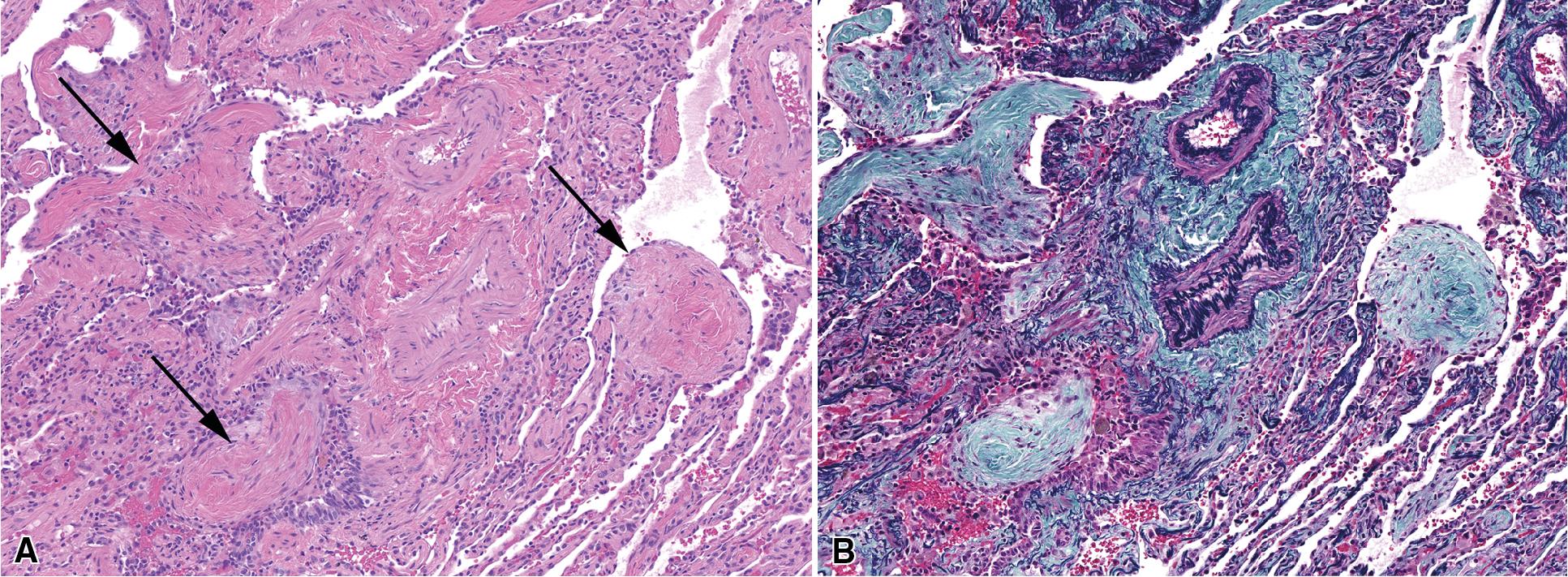
Unfortunately, this development is associated with a lack of response to treatment and progression of disease. ,
The expected response to systemic corticosteroid therapy is excellent. , , Because relapses may occur if therapy is stopped abruptly, patients with COP generally require extended corticosteroid tapering, sometimes over a year or more. , , There appears to be a small subset of patients with OP who develop progressive fibrosis with remodeling. This has been called fibrosing OP or variant of organizing pneumonia with supervening fibrosis and does not have the same excellent prognosis as steroid-responsive OP. ,
A practical approach to biopsies showing the histopathologic pattern of OP is presented at the end of this chapter. The term organizing pneumonia alone is too broad in scope to be of clinical use. In general, it is fair to say that the presence of the organizing pneumonia pattern is much more commonly associated with slowly organizing infection, systemic CTDs, hypersensitivity pneumonitis, and idiosyncratic reaction to drug or medication rather than a “cryptogenic” disease.
Respiratory bronchiolitis (RB) is a histopathologic lesion of the small airways that is common in cigarette smokers. In some smokers, an exuberant form of RB occurs as a clinical and radiologic manifestation of diffuse ILD. This ILD manifestation of RB has been referred to as RBILD. RB, RBILD, and DIP have been proposed as existing along a continuum in smokers, with RB on the asymptomatic end of a spectrum that culminates in DIP on the other. The 2013 update on the classification of IIPs recognized the increasing use of the term smoking-related interstitial lung disease to describe the spectrum of pathologic findings seen in the setting of smoking. This term encompasses the spectrum of RB and DIP but also includes histologic findings seen in the setting of fibrosis that are not true interstitial pneumonias: smoking-related interstitial fibrosis (SRIF), and airspace enlargement with fibrosis (AEF). Both SRIF and AEF were described in the setting of lobectomy specimens for carcinoma and may be seen in the spectrum of RBILD and DIP. , Pulmonary Langerhans cell histiocytosis (PLCH) is also generally considered to be a smoking-related ILD. Whether RB, RBILD, and DIP are truly manifestations of a single disease process remains to be proved. Certainly all three have some histopathologic elements in common, but the two main clinical manifestations in the spectrum (RBILD and DIP) also differ in a number of ways clinically and radiologically.
Patients with RBILD are typically a decade younger than those with DIP and present in early midlife, with a mean age of 36 years in two studies. , A relationship between smoking pack-years and onset of disease suggests a dose-related effect, with a threshold in the vicinity of 30 pack-years. There tends to be a gender predilection toward men, , but men and women were equally affected in one study. Mild breathlessness and cough are the most common initial complaints. , Clubbing of the digits is unusual in RBILD. Pulmonary function abnormalities parallel the mild clinical symptoms and may show evidence of both obstruction and restriction, with mild reduction in the diffusing capacity.
The chest x-ray appearance of RBILD reflects the presence of disease centered on the airways, mainly with thickening of airway walls. Ground-glass opacity is seen in more than 50% of chest radiographs in RBILD. On CT scans, ground-glass opacities and centrilobular nodules are typical findings, often best seen at the periphery of the upper lung zones.
RB is a common reactive process in the lungs of cigarette smokers; its presence alone does not imply the manifestation of diffuse lung disease. Moreover, even when the histopathologic changes are diffuse and distinctive in the biopsy specimen, clinical correlation is required for accurate diagnosis. For example, a patient with a lung mass, which is resected and found to be a bronchogenic carcinoma, may have extensive RB in surrounding lung parenchyma. In the absence of a clinically and radiologically defined ILD, a diagnosis of RBILD would be inappropriate.
The essential morphologic constituents of RB are (1) scant inflammation around the terminal airways ( Fig. 8.24 ), (2) metaplastic bronchiolar epithelium extending out from terminal airways to involve alveolar ducts ( Fig. 8.25 ), and (3) variable numbers of lightly pigmented, dusty brown airspace macrophages within bronchiolar lumens and in immediate surrounding alveoli ( Fig. 8.26 ). Scant peribronchiolar fibrosis may be present and may extend to involve contiguous alveolar walls ( Fig. 8.27 ). When bronchiolocentric scarring is prominent, an alternative diagnosis, such as chronic hypersensitivity pneumonitis, should be considered. So-called SRIF can be seen in RBILD ; it is characterized by dense collagenous thickening of the alveolar septa without inflammation. The fibrosis is not consolidated, like that seen in UIP, but it can be patchy in the surgical biopsy, alternating with spared alveolar parenchyma. Such fibrosis does not appear to progress to honeycomb fibrosis. The presence of fibroblastic foci or destruction of the lung architecture should always raise the possibility of an alternative diagnosis, especially undersampled UIP.
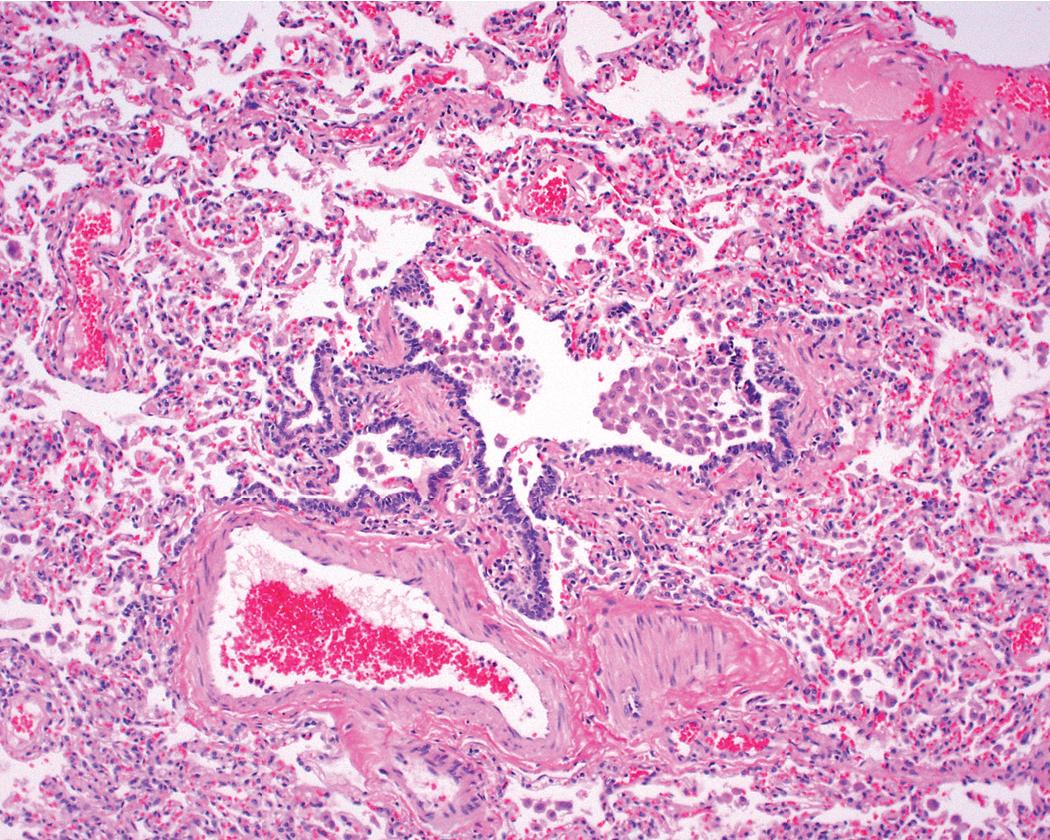
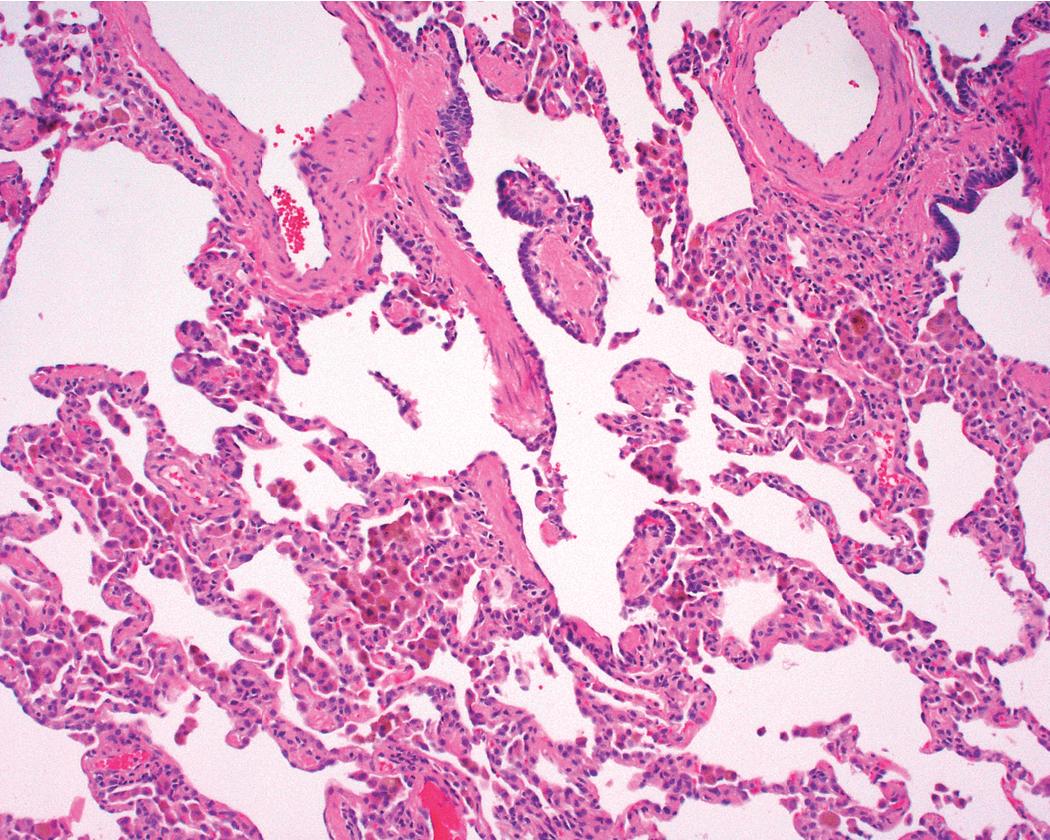
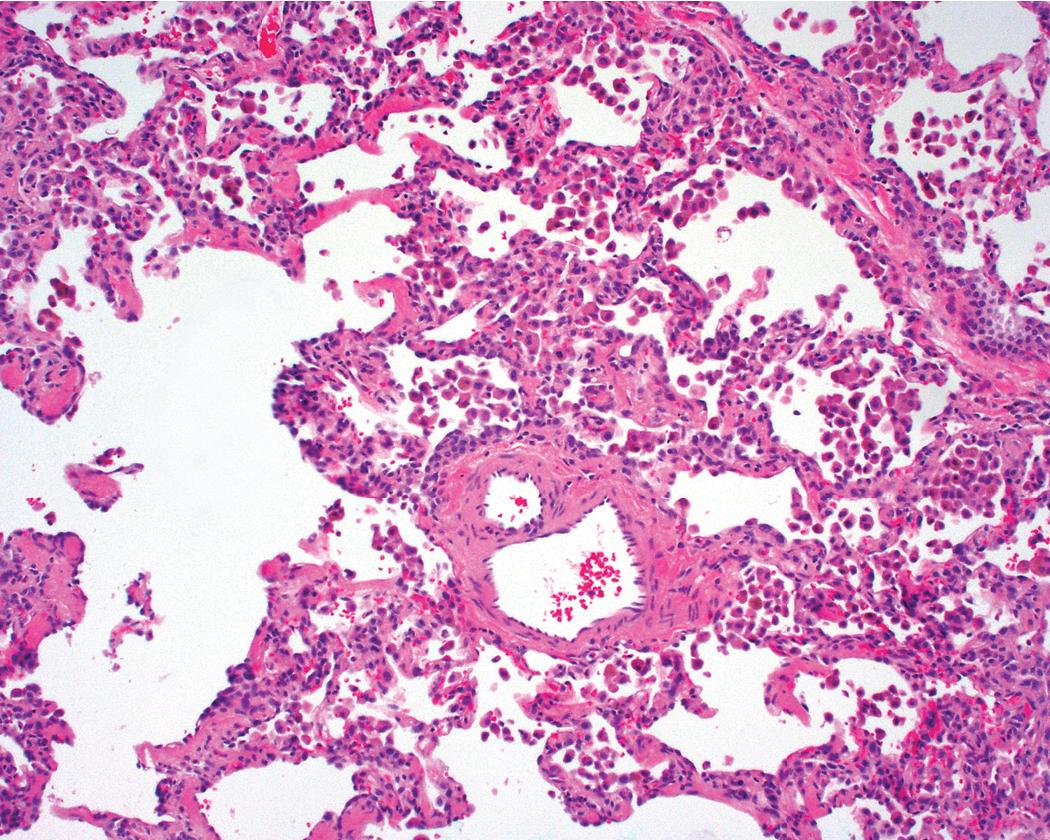
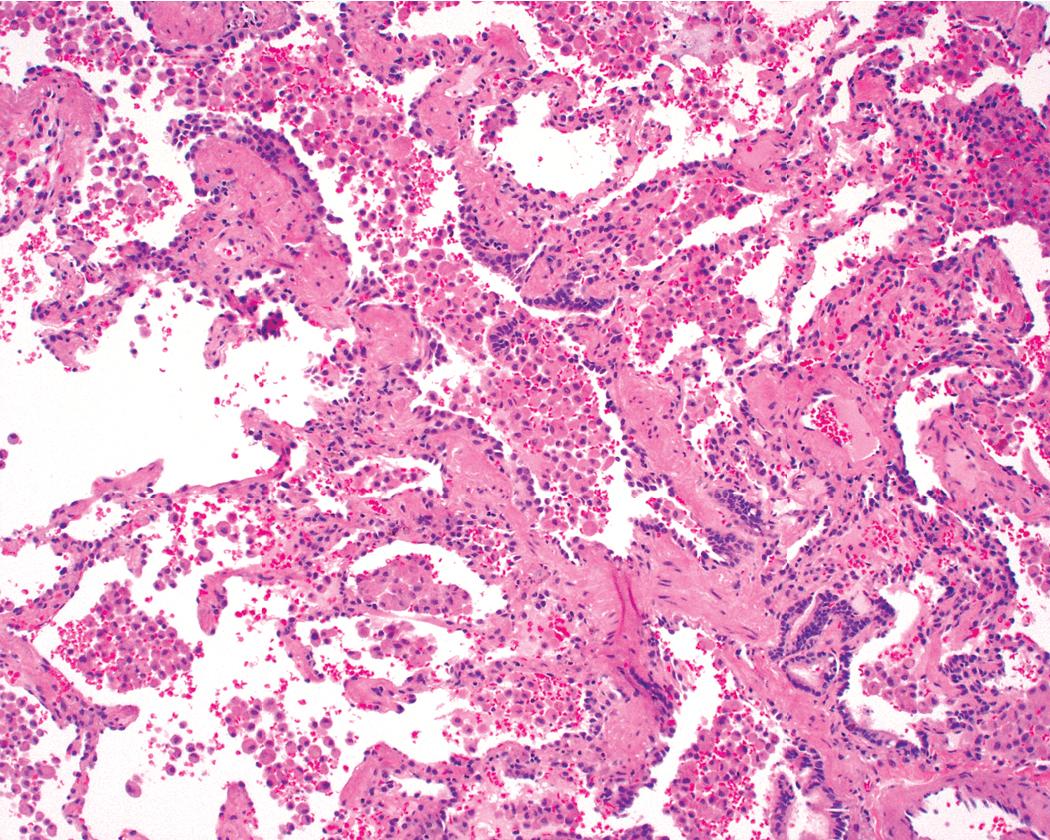
RB may be confused with other forms of bronchiolitis. When bronchiolar metaplasia is a prominent component, distinction from other small airway disease, such as idiopathic constrictive bronchiolitis, may be difficult. Patients with idiopathic constrictive bronchiolitis in surgical biopsies tend to have more severe pulmonary function abnormalities than patients with RB or RBILD (see Chapter 9 for a discussion of small airway disease). The distinction between RB and RBILD is largely based on the presence of clinical and radiographic abnormalities and cannot be made on histologic features alone.
RBILD generally carries an excellent prognosis. However, symptomatic or physiologic improvement occurs in a limited number of patients. Smoking cessation, with or without immunosuppressive therapy, has been recommended, but a recent report demonstrated benefit in only a small subset of patients.
Liebow proposed the term desquamative interstitial pneumonia for a diffuse lung disease that occurred in patients who were typically 10 or more years younger than patients who developed UIP. The disease often presented in mid-adulthood, and most patients were cigarette smokers. Liebow also believed that the “desquamated” cells that filled the airspaces in DIP were epithelial cells. It has now been established that the airspace cells of Liebow’s DIP are mainly macrophages, and that DIP is not a credible precursor lesion for UIP, a conclusion supported by a number of authorities.
Our current concept of DIP overlaps with that of RBILD, with both being considered components of the smoking-related diffuse lung diseases (see the discussion of PLCH further on). Whether DIP occurs as a separate disease in nonsmoking adolescents remains debatable, but it is unlikely. Another debate is centered on whether a form of UIP coexists with DIP as a “hybrid” entity. Those who still believe that DIP is a precursor lesion to UIP embrace this as proof of concept for instances in which this association is suggested in surgical lung biopsies. The counterargument is that smokers accumulate alveolar macrophages in areas of lung fibrosis, and because a majority of patients with UIP are current or former smokers, some of these patients will have prominent smoker-type macrophages coexisting with UIP. Recently, some have proposed to eliminate DIP as a diagnostic term because it does not accurately characterize the pathologic process, has poor disease specificity, and confusingly is classified as a smoking-related idiopathic lung disease. Time will tell if DIP as a diagnostic term has met the end of the road.
As currently defined, DIP is a very rare smoking-related lung disease. Patients with DIP are typically older than those with RBILD and roughly a decade younger than those with UIP. , Most patients with DIP are cigarette smokers; men are more frequently affected than women. Like UIP, the clinical presentation is dominated by an insidious onset of dyspnea and dry cough over several weeks or months. , Digital clubbing is present in 50% of patients with DIP, a finding in sharp contrast with RBILD. The symptoms of DIP are usually more pronounced and more severe than those of RBILD, supported by pulmonary function testing showing mild restriction and moderate reduction in diffusing capacity.
The chest radiograph may be normal in 3% to 22% of patients. When abnormalities are present, patchy areas of ground-glass opacification predominate. The lung bases and periphery are most commonly affected. , , On CT scans, ground-glass opacification is universally present, mostly in a bibasilar distribution. Linear and reticular opacities may accompany ground-glass opacities at the bases but tend to be quite limited in extent. Focal areas of peripheral honeycombing may be identified in as many as one third of patients, but when these are prominent and associated with more pronounced reticular abnormalities, an alternate diagnosis should be considered (probably UIP).
On scanning magnification, the surgical lung biopsy in DIP has an eosinophilic appearance due to the presence of eosinophilic macrophages uniformly filling airspaces ( Fig. 8.28 ). , Mild interstitial thickening by fibrous tissue is the rule and is uniform in appearance ( Fig. 8.29 ). When chronic inflammation is evident at scanning magnification, it is centrilobular and associated with respiratory bronchioles ( Fig. 8.30 ). Scant numbers of plasma cells and rare eosinophils may be seen within slightly thickened alveolar walls at high magnification ( Fig. 8.31 ).
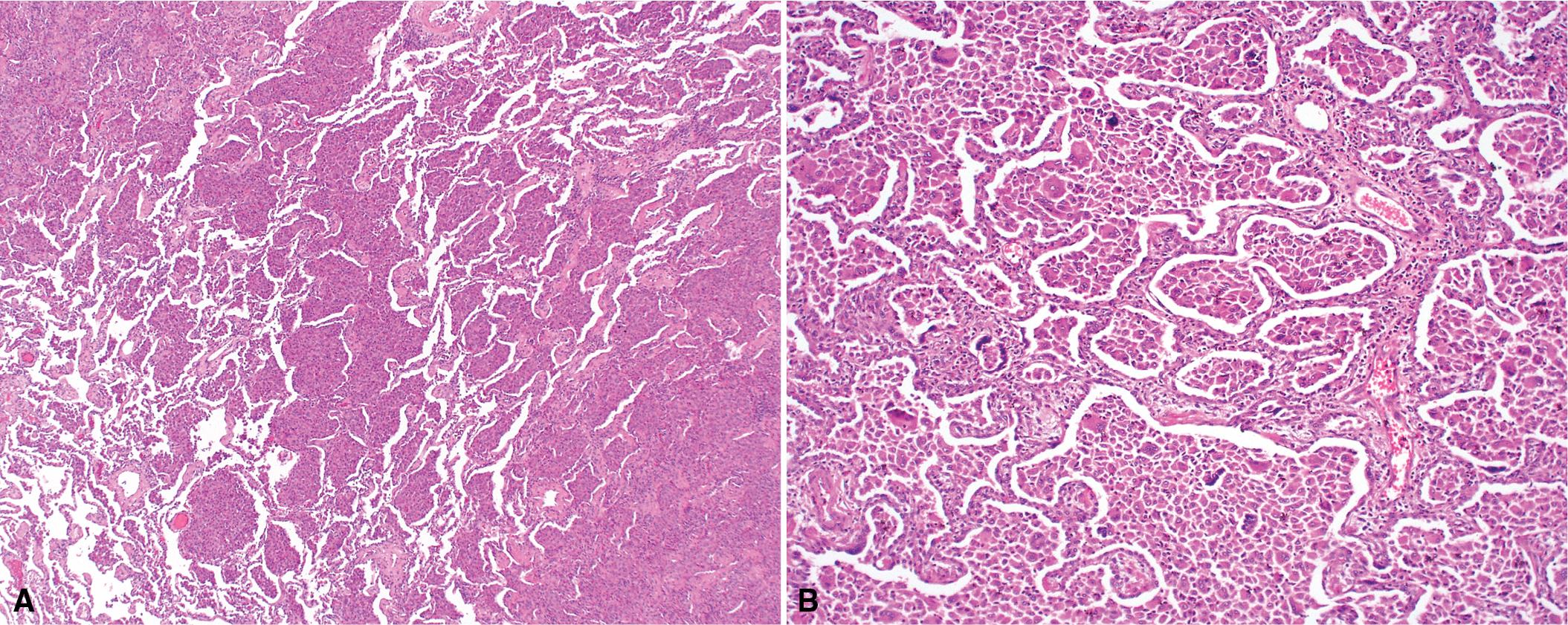
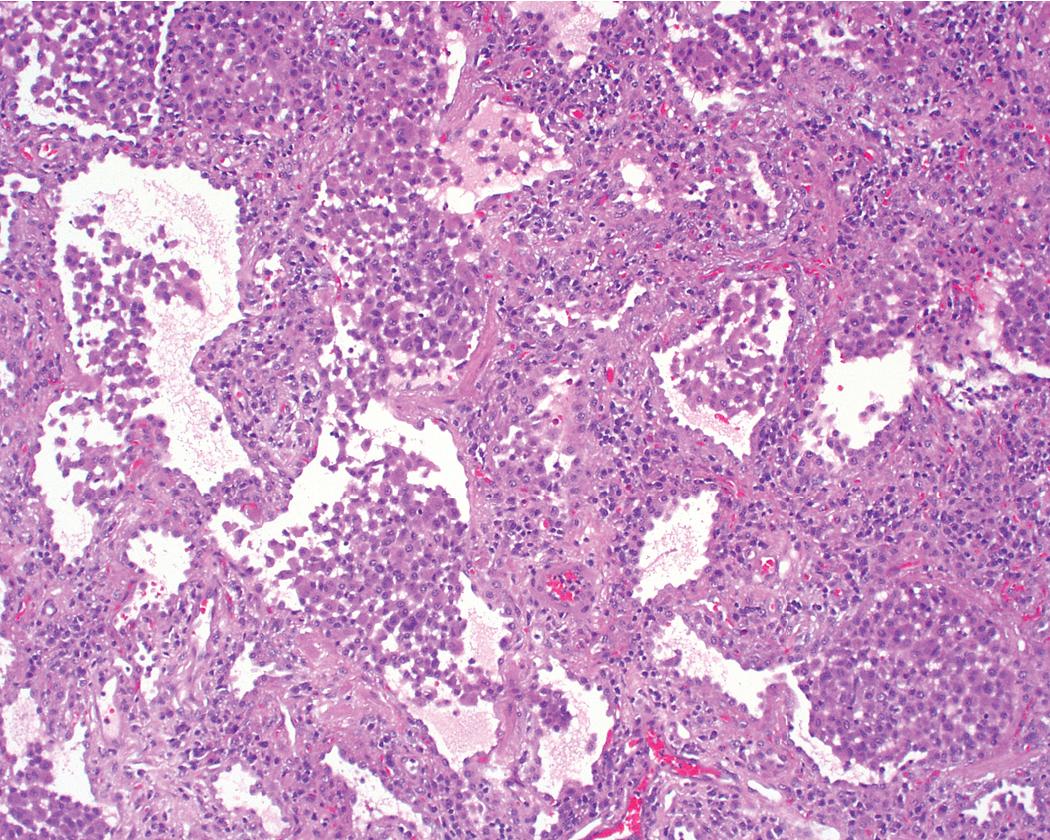

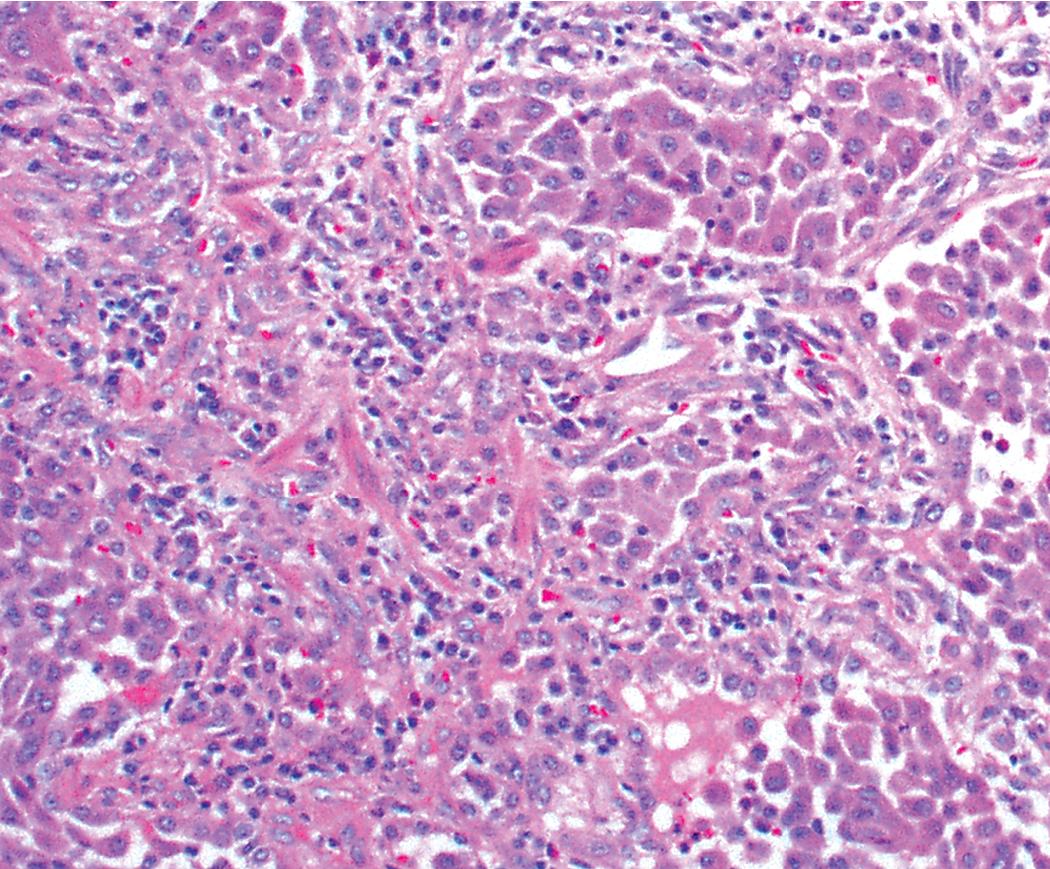
An attempt to distinguish DIP from RBILD is probably a useless exercise for pathologists; the inclusion of these two smoking-related diseases together as a diagnostic entity seems reasonable in the absence of clinical and radiologic data. Eosinophilic lung disease can simulate the low-magnification appearance of DIP, as can chronic passive congestion, pulmonary hemorrhage syndromes, GIP in hard metal disease, and PLCH (pulmonary histiocytosis X) when a prominent “DIP reaction” is identified. Progression to end-stage fibrotic lung disease is atypical and should raise consideration of alternative diagnoses including comorbid disease, such as UIP. Classic histologic features of DIP are rarely encountered in non smokers. In these settings, it is important to inquire about other forms of smoke exposure (pipes or secondhand smoke). In very rare circumstances, CVD can present with DIP and this possibility should be mentioned in the pathology report.
As with RBILD, the prognosis for patients with DIP tends to be good, with an estimated 10-year survival rate of 70%. Smoking cessation and corticosteroid therapy have proved effective in older studies.
LIP was originally thought of as a chronic cellular interstitial pneumonia with distinctive histopathologic features, quite different in cellular composition and form from Liebow’s other IIPs (e.g., UIP, bronchiolitis obliterans interstitial pneumonia, DIP, GIP). LIP became controversial because many of the cases originally classified as LIP by Liebow (and his contemporaries) evolved into (or were actually indolent forms of) low-grade lymphoproliferative disease involving the lung. It is now generally acknowledged that the accrual of dense lymphoid tissue in the lung carries strong implications for lymphoproliferative disease, especially small B-cell lymphomas of the extranodal marginal zone type (so-called lymphomas of the mucosa-associated lymphoid tissue [MALT]) and polymorphous lymphoproliferative disorders associated with viral infection, including EBV or human T-lymphotropic virus type 1 (HTLV-1). LIP , as currently defined, is included as an entity in this chapter because it has been retained as a rare form of IIP, partly for historical reasons. The panel participants acknowledged that many pulmonary pathologists might classify the described histopathologic findings of “idiopathic LIP” as a cellular form of NSIP. In practice, an outright diagnosis of LIP is rare compared to cellular NSIP.
More recently, Cha and colleagues described a series of nonlymphoma LIP cases in which 9 of 15 patients were found to have a CTD, mainly Sjögren syndrome. In that series, three patients with idiopathic LIP were identified. All three survived longer than 10 years, and their disease did not progress to lymphoma or leukemia despite the fact that one had a monoclonal gammopathy.
The clinical manifestations of the idiopathic form of the LIP pattern are not well studied but seem to be similar to those associated with definable systemic conditions, such as CVD. Women are more commonly affected than men; patients are typically between 40 and 50 years of age. Interestingly, all of the “idiopathic LIP” patients described by Cha and colleagues were men, whereas most of the secondary LIP patients were women. Slowly progressive breathlessness is a common feature, with or without nonproductive cough; the disease may evolve over months or years.
In the classic description of LIP, systemic signs and symptoms such as weight loss, pleuritic pain, arthralgias, adenopathy, and fever were reported, depending on whether an associated systemic condition was present. , Findings may include bibasilar crackles, cyanosis, and clubbing. Immunoglobulin abnormalities in serum are present in some patients. More commonly, the LIP pattern is associated with a systemic condition that dominates the clinical presentation and clinical course (e.g., Sjögren syndrome, pernicious anemia, hypogammaglobulinemia).
The published radiologic features of idiopathic LIP seem to describe more than one pattern of disease. Bibasilar reticular opacities along with ground-glass attenuation and thickening of interlobular septa are frequently observed abnormalities. There may be mixed alveolar and interstitial infiltrates and thin-walled cysts, honeycombing, and changes suggesting pulmonary hypertension late in the disease. , Nodular patterns can also occur. Pleural effusion is rare and, if present, should increase concern for low-grade malignant lymphoma.
A distinctive cystic disease has also been referred to by radiologists as lymphocytic interstitial pneumonia (or simply, LIP); on biopsy, however, the process has no significant interstitial inflammatory infiltrates or fibrosis, exhibiting only thin-walled, dilated airways with scant associated bronchiolitis. An association with Sjögren syndrome has been documented. It is important to note that radiologic LIP and pathologic LIP are not entirely referring to the same pathologic process. Pathologic LIP would appear as infiltrates on imaging while radiologic LIP appears as mostly normal lung on pathology.
The histopathologic pattern in LIP is characterized by the presence of a dense and diffuse alveolar septal infiltrate made up of lymphocytes, plasma cells, and histiocytes ( Fig. 8.32 ). This definition helps exclude diseases with less intense cellular interstitial infiltrates, such as certain hypersensitivity reactions and systemic CTDs. Multinucleated giant cells or small, ill-defined granulomas in the interstitium have been described in the idiopathic form of LIP, but microscopic honeycomb remodeling with some interstitial fibrosis ( Fig. 8.33 ) can also be a part of idiopathic LIP. To a variable extent, germinal centers may be present along airways and lymphatic routes ( Fig. 8.34 ). When these are prominent and interstitial lymphocytic infiltration is less remarkable, diffuse lymphoid hyperplasia has been used as a preferable term. In this situation, lymphoproliferative disorders—such as multicentric Castleman disease, idiopathic plasmacytic lymphadenopathy with hyperimmunoglobulinemia, or even MALT lymphoma—are the main considerations. When the idiopathic form of the LIP pattern is identified, immunophenotyping and gene rearrangement studies typically show an absence of clonality. When nodular lymphoid hyperplasia is prominent around bronchioles, typically accompanied by an interstitial infiltrate, Sjögren syndrome should be rigorously investigated as a potential etiology.
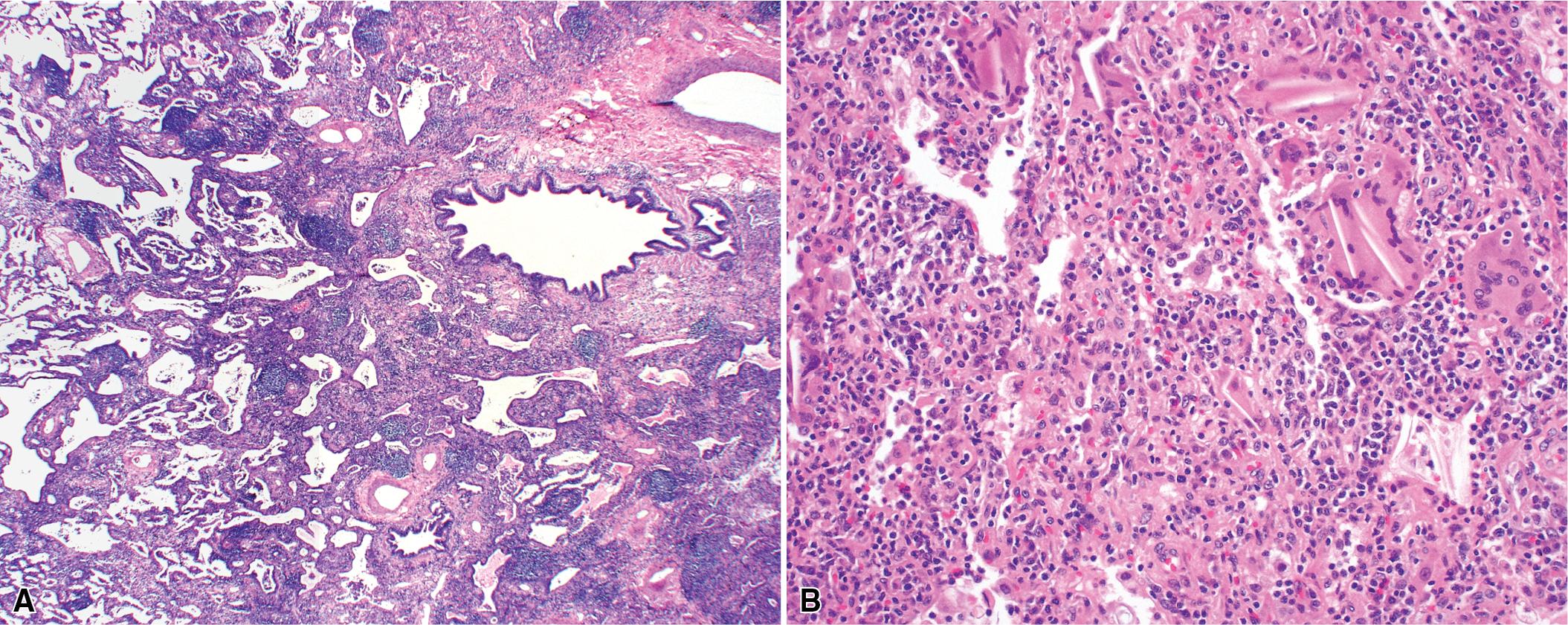
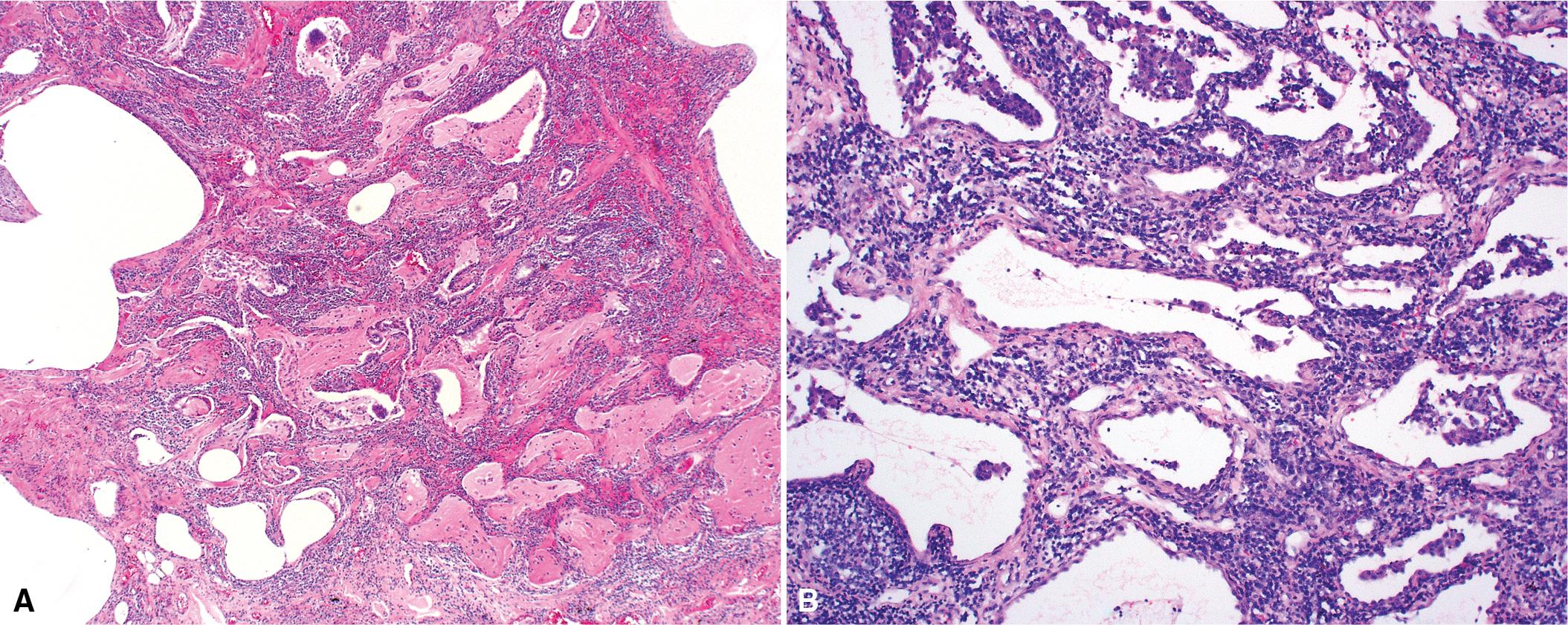
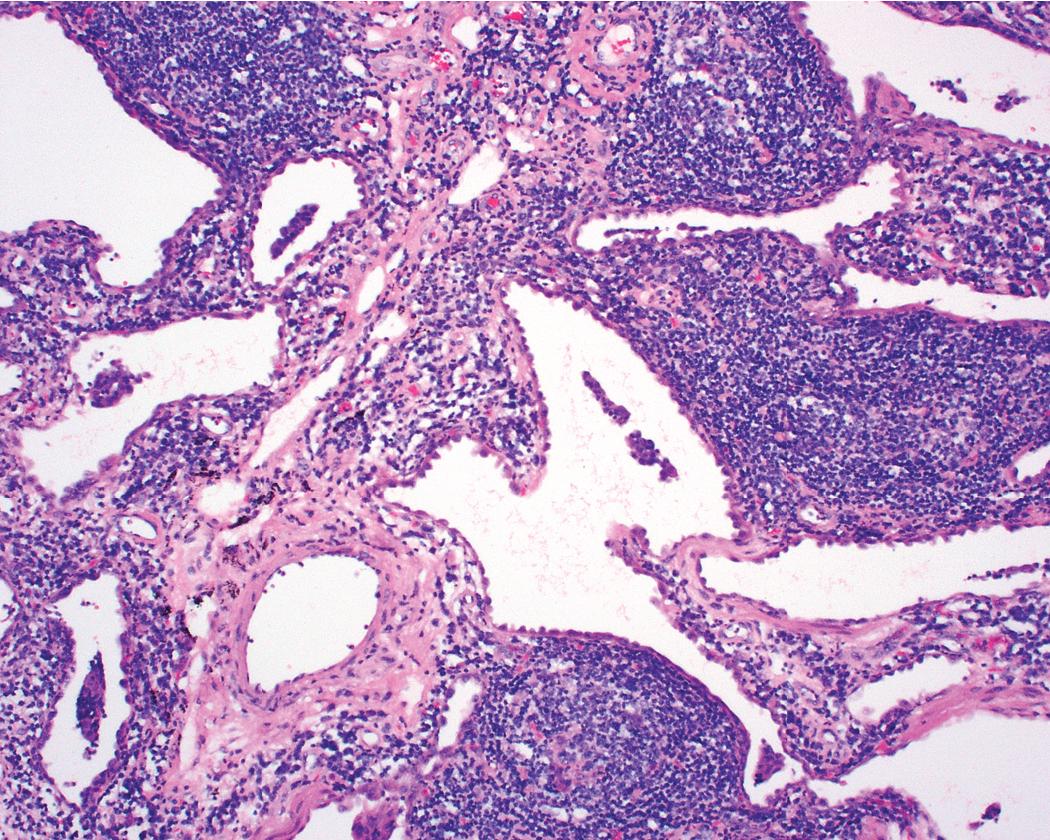
The LIP pattern is most consistently seen when systemic CVDs manifest in the lung. The LIP pattern may also be seen in the setting of bone marrow transplantation and has frequently been observed in both children and adults who have congenital or acquired immunodeficiency syndromes ; it is also seen in the setting of adult humanimmunodeficiency virus (HIV) infection, including vertical transmission from mother to child.
Much of what has been written about the histopathology of LIP is similar to writings about the histopathologic patterns of NSIP. If LIP and cellular NSIP can be distinguished from each other microscopically, it is usually on the basis of the sheer density of the lymphoid infiltrate in LIP, accompanied by fibrosis and some degree of remodeling (the latter would be unexpected for the cellular form of NSIP). Naturally, in this setting gene rearrangement studies are important in distinguishing idiopathic LIP from low-grade lymphoproliferative disease (see Chapter 16 for further discussion). Once the pattern is established, it is useful to suggest the potential systemic conditions that may be associated with this pattern ( Box 8.9 ) in a “comment” section of the surgical pathology report. In practice, a diagnosis of LIP is quite rare compared with cellular NSIP, emphasizing the idea that the infiltrate seen in LIP should be robust enough to strongly suggest the possibility of lymphoma. Some pathologists will use their histologic impression for the possibility of lymphoma to guide the use of LIP versus cellular NSIP, with the former being retained for cases with concerning morphologic features for lymphoma. A practical approach to biopsies with dense cellular infiltrates is provided at the end of this chapter.
Certain infections (e.g., Pneumocystis jirovecii pneumonia, Epstein-Barr virus infection, HIV infection)
Connective tissue diseases (Sjögren syndrome, rheumatoid arthritis, systemic lupus erythematosus)
Immune deficiency diseases (HIV infection, heritable immunodeficiency syndromes)
Autoimmune diseases (Hashimoto thyroiditis, myasthenia gravis, pernicious anemia)
Drug- or toxin-related lung injury
Lymphoproliferative disorders (multicentric Castleman disease, idiopathic plasmacytic lymphadenopathy with hypergammaglobulinemia, IgG4-related disease)
The clinical outcome and response to therapy for patients with the LIP pattern is largely dependent on whether systemic disease is present. In the idiopathic form, an accurate prognosis has not been forthcoming, although three patients survived more than 10 years in the series reported by Cha and coworkers. In symptomatic patients, corticosteroid administration may result in significant benefit, lending further support to LIPs being an immunologic disease rather than a neoplastic one in most instances. When honeycomb cysts, clubbing, or cor pulmonale is present, the prognosis is less favorable, with as many as one third of patients succumbing to the disease. , Infection is a common complication, especially when LIP is associated with dysproteinemia. , ,
In 1992, Amitani and coworkers reported a distinctive pattern of upper pulmonary lobe fibrosis in Japanese patients. Subsequently, Frankel and coworkers referred to a similar form of pleuroparenchymal ILD as idiopathic pleuroparenchymal fibroelastosis (IPPFE). This upper lobe–predominant fibrotic disease slowly progresses to involve the lower lung. On histopathologic examination, elastotic fibrosis, similar to that seen in an apical cap, is the dominant feature. The major differences between apical cap and IPPFE are that the patients with IPPFE are symptomatic and the disease is progressive; it can result in death within several years. The pathogenesis of IPPFE is unknown. A recent study reported that wide areas of alveolar epithelial denudation are a core event in the development of IPPFE, which results in lung collapse due to surfactant dysfunction. Interestingly, IPPFE associated with bone marrow transplantation also shows a lymphocytic infiltration that destroys the alveolar epithelium resulting in similar denudation. The 2013 updated classification of IIPs placed IPPFE in the category of rare IIPs.
The median age of a patient diagnosed with IPPFE is 57 years, and there is no sex predilection. Patients present with dyspnea on exertion and cough. Pneumothorax and recurrent infections have been reported in some patients. Reports have raised the possibility of familial and neoplastic associations with IPPFE.
Plain films show volume loss in both upper lungs with marked apical pleural thickening. CT images show marked visceral pleural thickening extending into the lung parenchyma, with subpleural reticular abnormalities. Traction bronchiectasis is a common finding in areas of fibrosis. Lower lung zones may be hyperinflated.
The histopathology of IPPFE overlaps with that of apical cap. Fibrotic areas show dense elastotic scarring without significant inflammation. From low magnification, the fibroelastic process should extend deep into the underlying lung parenchyma ( Fig. 8.35 A). Elastotic scarring is differentiated from typical scarring by the presence of fine light gray colored elastic fibers embedded in the fibrosis (see Fig. 8.35 B). These fibers impart a lighter gray color to the fibrosis from low power, often the first clue to IPPFE. Although the elastic fibers can be highlighted with elastic tissue stains, there are rarely required in clinical practice. Scattered lymphoid aggregations are common, but there is no associated cellular interstitial pneumonia. Margins between normal lung and affected fibrotic areas are sharply defined. Uninvolved lung shows minimal abnormalities, mainly involving the airways (bronchiolar fibrosis or ectasia). Broad pleural adhesions, probably due to the common history of pneumothorax, may be present.
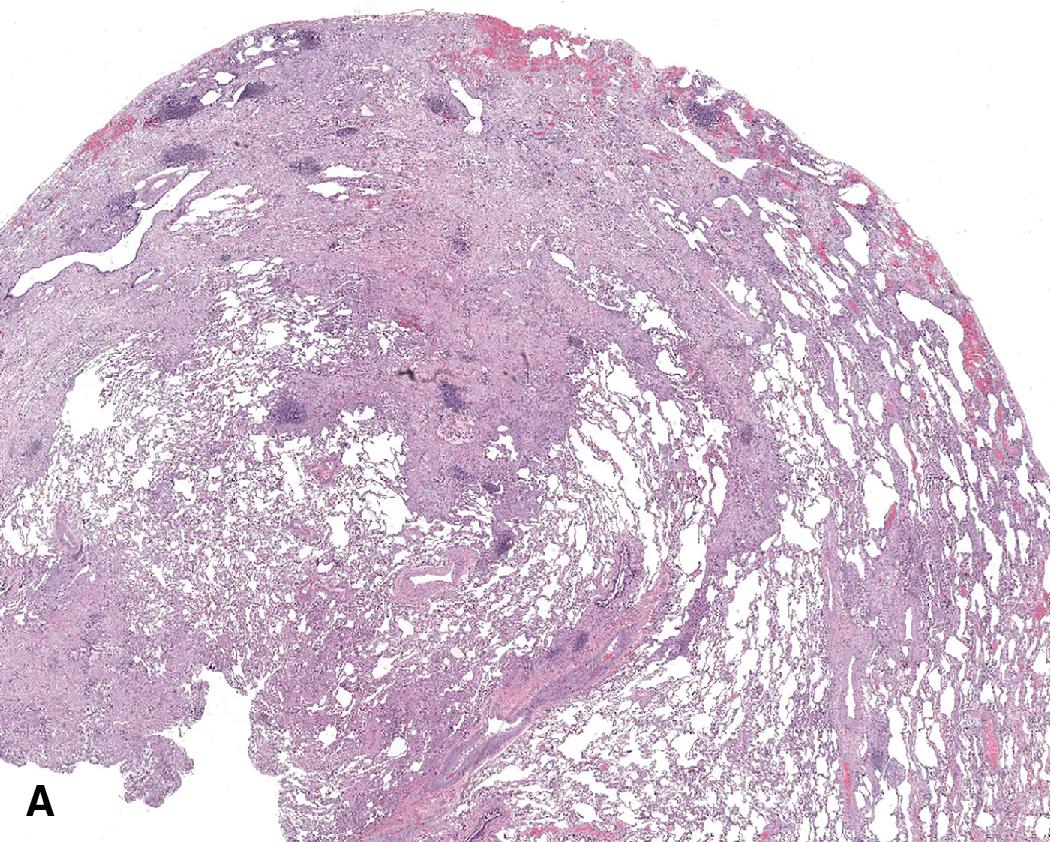
The histologic distinction between apical cap and IPPFE can be quite challenging. Apical cap should be relegated to the immediate subpleural zone, while IPPFE shows finger-like projections deeper into the lung parenchyma. The background elastotic fibrosis is identical between the two. The progressive and “infiltrative” fibrosis of IPPFE can affect survival through eventual loss of lung compliance. The presence of dense collagenous fibrosis (that lacks elastic fibers) should raise an alternative diagnosis, such as UIP or fibrotic NSIP. Honeycomb fibrosis in the lower lung is not an expected finding in patients with IPPFE and again should suggest UIP. Some cases of UIP may show more significant elastosis and there may be a morphologic overlap between UIP and IPPFE. In these scenarios, UIP should lead the differential diagnosis and correlation with imaging findings may help clarify the anatomic distribution of the process.
The expected clinical course varies considerably from case to case; however, up to 40% of patients may die of the disease. ,
Systemic CVDs play an extremely important role in the etiology of ILDs. Knowledge of rheumatic ILD is derived mainly from retrospective studies, typically including small numbers of patients. Because of differences in patient populations reported and in the severity (and duration) of rheumatic disease at the time of study, many important questions remain concerning the frequency, pathogenesis, natural history, clinical relevance, and prognosis of ILD occurring in the rheumatic diseases. It is estimated that ILD in CVD is responsible for 1600 deaths annually in the United States, accounting for roughly 25% of all ILD deaths and 2% of all deaths from respiratory causes. Not surprisingly, most interstitial pneumonia patterns raise CVD as a consideration in the differential diagnosis. On the other hand, certain CVDs are associated with reasonably reproducible findings in the lung. Table 8.3 summarizes the different patterns of inflammatory lung disease that have been described as lung manifestations of the known CTDs. The five rheumatic diseases that are more commonly associated with ILD are (1) RA, (2) progressive systemic sclerosis (PSS), (3) systemic lupus erythematosus (SLE), (4) polymyositis-dermatomyositis (PM-DM), and (5) Sjögren syndrome. The estimated frequency of lung involvement and the patterns produced are presented in Table 8.4 . This section is restricted to the more chronic manifestations of these diseases. Acute lung manifestations of the rheumatic diseases are described in Chapter 6 .
| Manifestation | RA | SLE | PSS | PM-DM | MCTD | SS | AS |
|---|---|---|---|---|---|---|---|
| Pleural inflammation, fibrosis, effusions | X | X | X | X | X | X | X |
| Airway disease | |||||||
| Inflammation (bronchiolitis) | X | X | X | X | X | ||
| Constrictive bronchiolitis | X | X | |||||
| Bronchiectasis | X | X | |||||
| Follicular bronchiolitis | X | X | X | X | |||
| Interstitial disease | |||||||
| Acute (DAD), with or without hemorrhage | X | X | X | X | X | ||
| Subacute/organizing (OP pattern) | X | X | X | X | X | X | |
| Subacute cellular | X | X | X | X | X | ||
| Chronic cellular and fibrotic | X | X | X | X | X | X | |
| Eosinophilic infiltrates | X | X | |||||
| Granulomatous interstitial pneumonia | X | X | X | ||||
| Vascular diseases; hypertension/vasculitis | X | X | X | X | X | X | |
| Parenchymal nodules | X | ||||||
| Apical fibrobullous disease | X | X | X | ||||
| Lymphoid proliferation (reactive, neoplastic) | X | X | X |
| Disease | Estimated Frequency | Type of ILD | Anatomic Involvement/Dominant Finding |
|---|---|---|---|
| Rheumatoid arthritis (RA) | 20% | UIP/NSIP ⪢ OP | Pleuritis > bronchiolitis > ILD > RA nodule |
| Progressive systemic sclerosis , | 40% | NSIP ⪢ OP > UIP > DAD | ILD > aspiration > PHT |
| Systemic lupus erythematosus , | <10% | DAD > DAH > OP > UIP/NSIP | Pleuritis > infection > ILD > PHT |
| Polymyositis-dermatomyositis | 10%–35% a | NSIP > DAD > OP > UIP | Aspiration > ILD |
| Sjögren syndrome | 25% | NSIP > OP > UIP > LIP | Bronchiolitis > ILD |
| Mixed connective tissue disease | 40% | UIP/NSIP > OP > DAD > DAH | ILD > pleuritis > PHT > aspiration |
a 75%–100% when patient is seropositive for Jo-1, CADM-140, or other aminoacyl-tRNA synthetase (ARS). ,
RA is a chronic systemic disease that produces symmetrical arthritis and occurs more commonly in women than in men. ILD was not recognized as a manifestation of RA until 1948, possibly because lung manifestations of the disease are difficult to recognize on purely clinical grounds. Today, with the use of pulmonary function testing, bronchoalveolar lavage, and CT imaging, significant lung disease is identified in 14% of patients who meet the American College of Rheumatology (formerly the American Rheumatism Association) criteria for RA; subclinical disease is seen in as many as 44%. Interestingly, men are 3 times more likely to develop ILD with RA than are women. Clinically significant ILD in RA is associated with increased morbidity and mortality.
Diffuse lung disease in RA is typically noted in patients with diagnosed RA; rarely, however, ILD may precede articular manifestations. , The clinical presentation is dominated by shortness of breath and cough. Adults are more commonly affected than children, and despite a higher incidence of RA in women, men with long-standing rheumatoid disease and subcutaneous nodules seem to develop lung manifestations more often. Physical examination may reveal bibasilar inspiratory crackles, digital clubbing, and evidence of cor pulmonale, the last due to pulmonary hypertension arising as a result of hypoxic vasoconstriction. , When fibrosis and honeycomb remodeling accompany diffuse lung disease in RA, UIP enters into the differential diagnosis. Affected patients are often younger than those with idiopathic UIP. Cigarette smoking has been reported to be an independent predictor of lung disease in persons with RA.
Several radiologic manifestations are described in RA, including reticular opacities with or without honeycombing, airway-associated abnormalities (bronchiectasis, nodules, centrilobular branching lines), and parenchymal opacities. When ground-glass infiltrates and reticular opacities are present, there is a predilection for involving the bases and lung periphery. High-resolution CT findings include ground-glass attenuation with mixed alveolar and interstitial infiltrates. As lung disease advances, dense reticular and nodular opacities appear, and honeycomb lung may be seen in late stages of the disease. ,
Despite the seemingly nonspecific nature of the histopathologic manifestations of RA, a few key elements emerge on review of many well-documented cases of RA-associated ILD. Chronic inflammation, in the form of lymphocyte aggregates and germinal centers, is typical though not unique ( Fig. 8.36 ). Most of the lymphoid aggregations are present around the terminal airways (“follicular bronchiolitis” when lymphoid germinal centers are prominent) ( Fig. 8.37 ), but lymphoid follicles may also present in the pleura. In fact, the presence of chronic pleuritis should always raise RA as a consideration in the differential diagnosis. Areas of subacute lung injury attended by reactive type II cells and airspace organization ( Fig. 8.38 ) can be seen with cellular interstitial pneumonia ( Fig. 8.39 ) and variable interstitial fibrosis ( Fig. 8.40 ). This combination of subacute and chronic inflammatory reactions haphazardly involving the same lung biopsy, including the pleura, should raise the possibility of RA lung disease. When fibrosis is prominent, it is often difficult to classify as UIP or NSIP. That may be one of the reasons for the variable reported incidence of these two patterns of fibrosis in the disease. Fibroblastic foci are usually less prominent and normal lung may be absent. Vasculitis (including capillaritis) and even pulmonary hemorrhage have been described as manifestations of RA lung. When silicosis occurs with RA, the resulting disease is referred to as Caplan syndrome. Rheumatoid nodules can occur in the lung and pleura and must be distinguished from granulomatous infection and granulomatosis with polyangiitis (GPA; previously known as Wegener granulomatosis ) (see Fig. 8.40 ). Rheumatoid nodules show central eosinophilic necrosis/necrobiosis with surrounding lymphoplasmacytic inflammation, giving the lesion a basophilic rim. Granulomatous infection shows a similar pattern. In contrast, nodules of GPA have central basophilic necrosis (often with abundant neutrophils) and surrounding collections of histiocytes appearing as an eosinophilic rim. Infection stains and correlation with final culture studies is imperative in all cases of granulomatous inflammation. Intrapulmonary lymph nodes may become prominent in RA and typically show reactive lymphoid hyperplasia when subjected to biopsy.
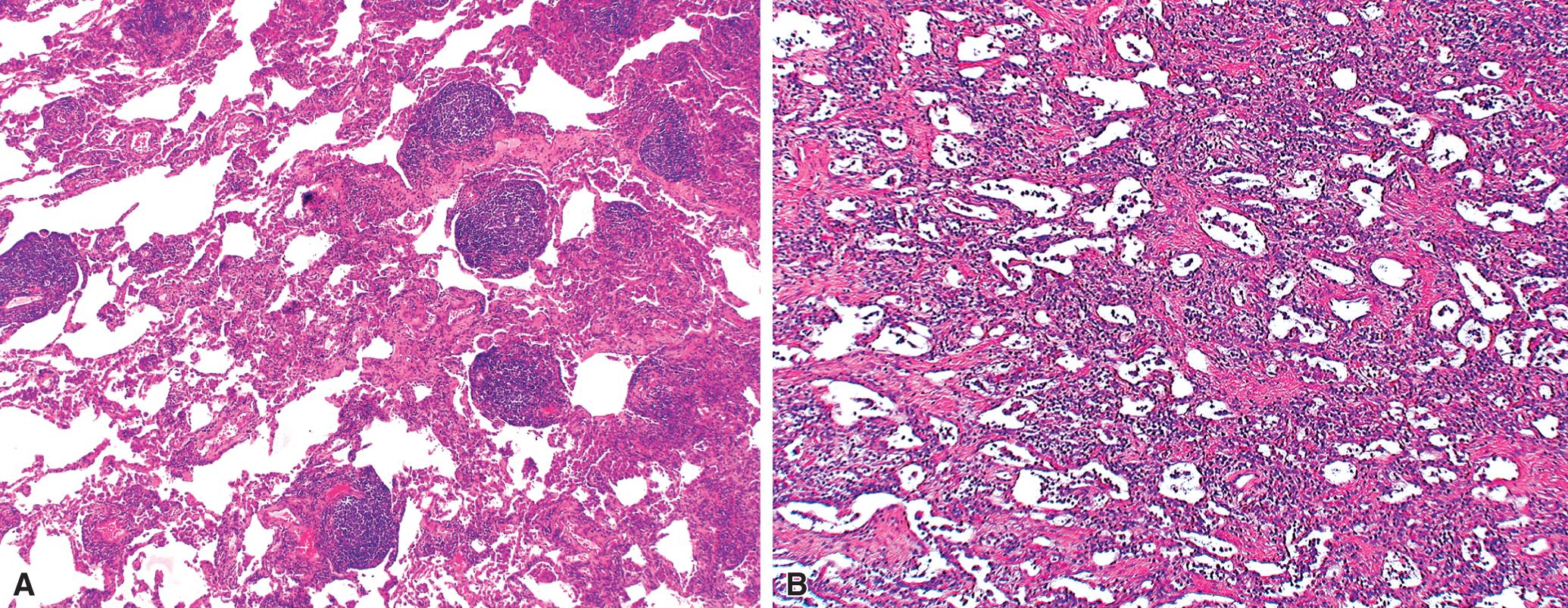
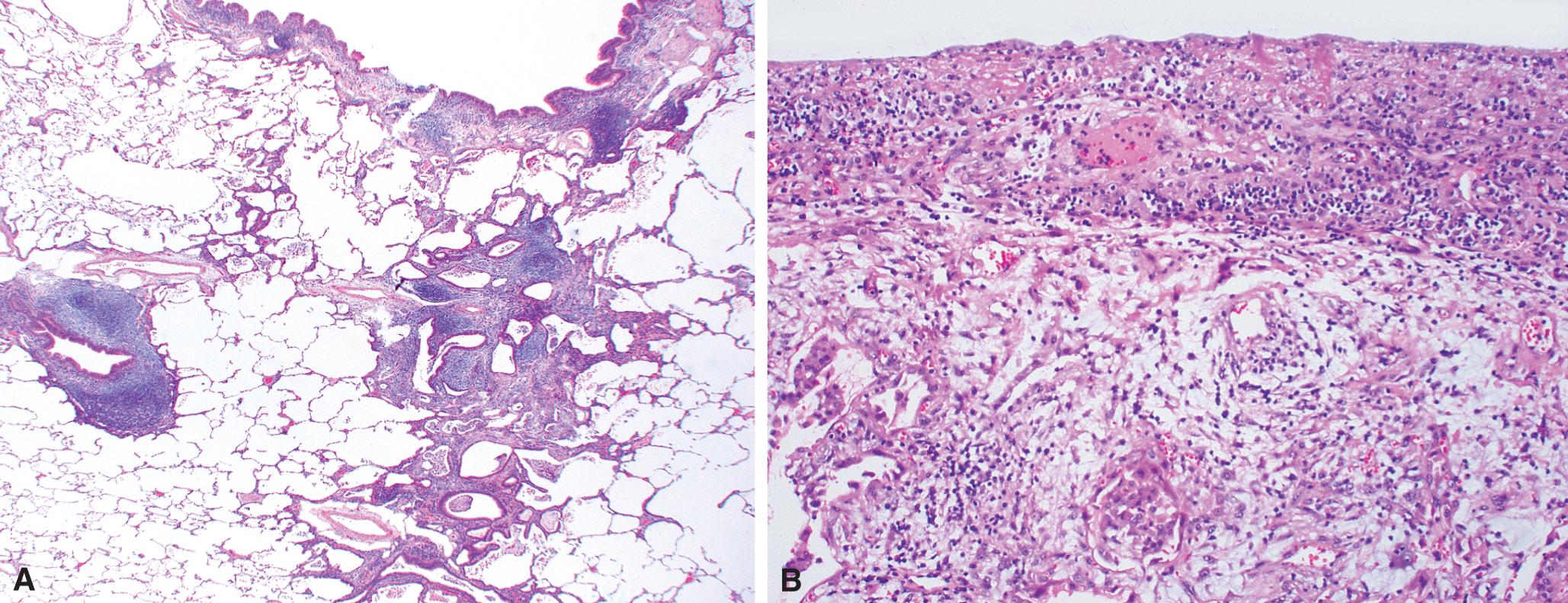
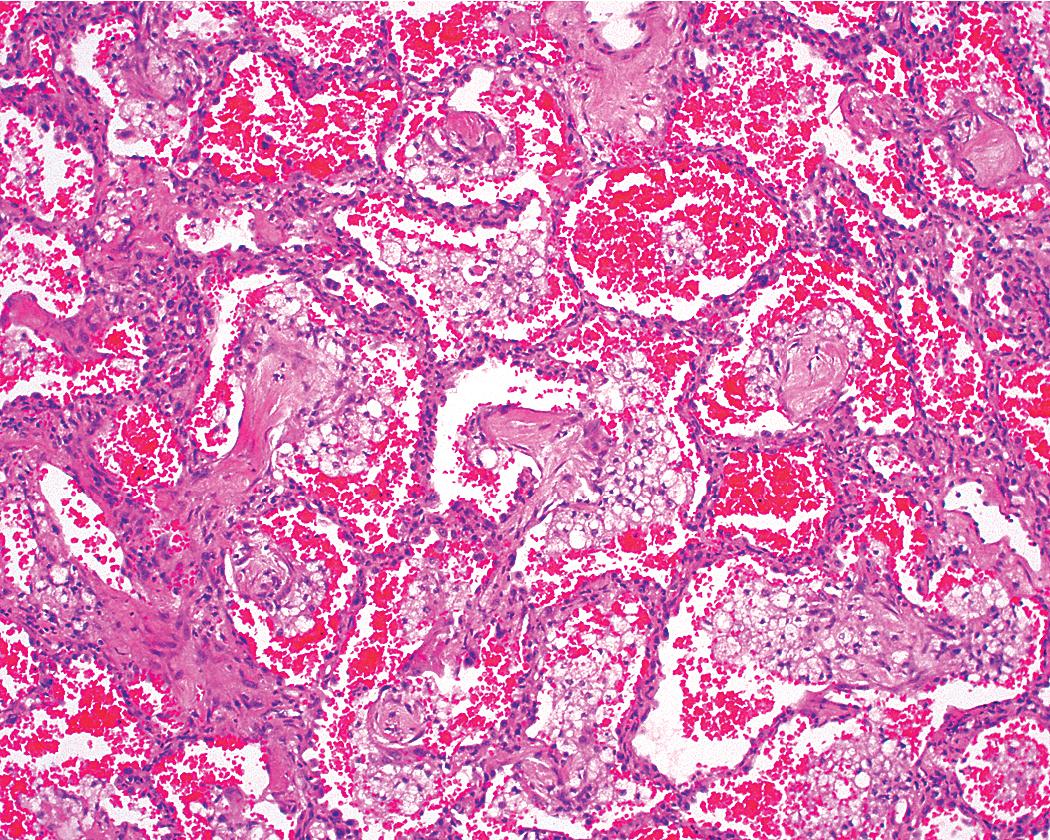
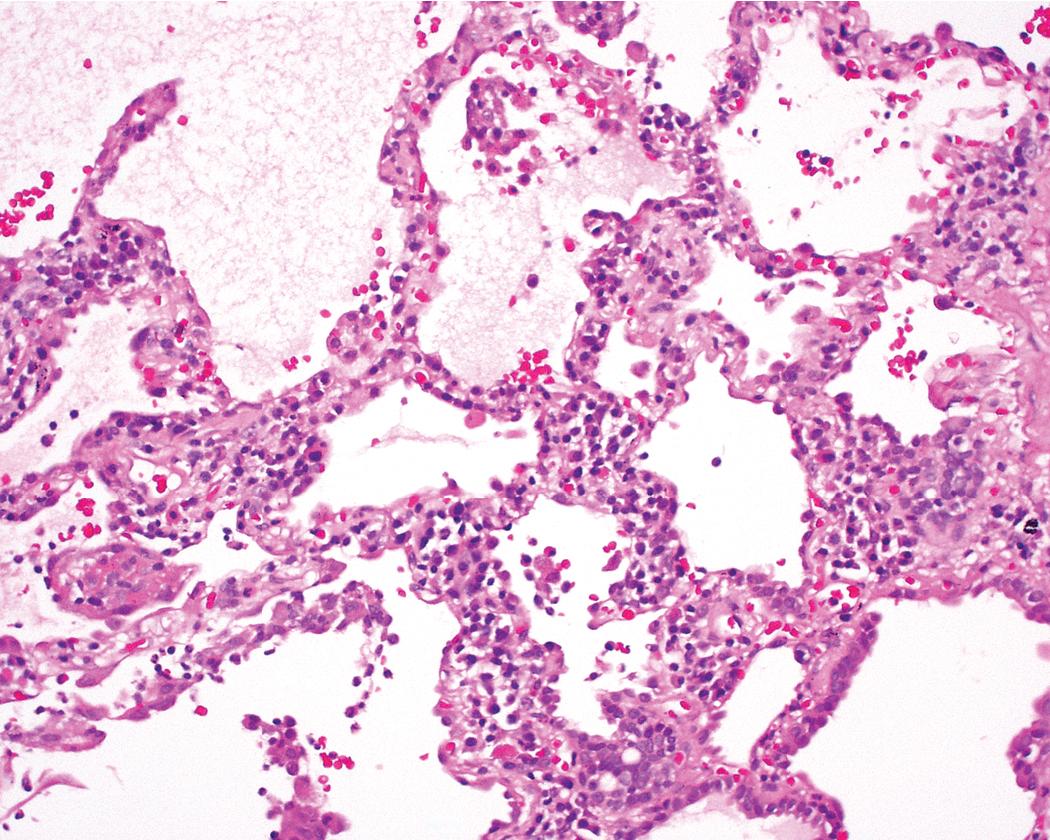
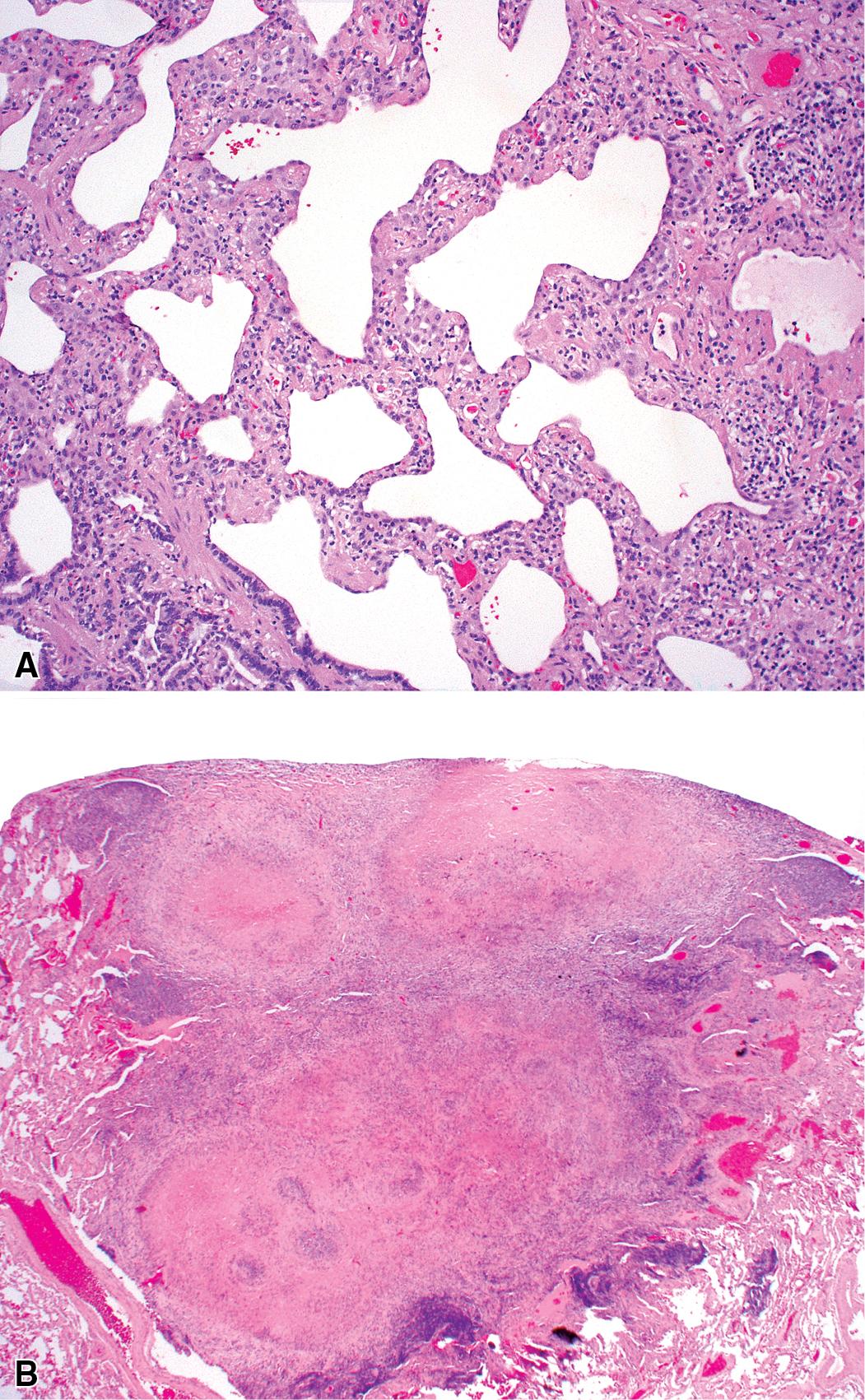
RA lung manifestations are frequently confused with the IIPs (COP, NSIP, or even UIP), especially when the lung disease precedes the systemic disease. In a minority of patients pulmonary disease may be the first manifestation of RA, even preceding serologic evidence of disease. In patients with RA who develop pulmonary symptoms, biopsies are usually performed only when superimposed lung infections or drug reactions are suspected clinically. Surgical lung biopsy in this context can be extremely difficult to interpret, given significant overlap in the morphologic patterns of drug reactions, low-grade infection, and the systemic CVD itself.
As with other CTDs, therapeutic strategies in RA have focused on immunosuppression and other disease-modifying antirheumatic drugs such as inhibitors of TNF, IL-6, or Janus kinases. Although the reported survival significance of RA-ILD varies, a majority of published papers indicate better survival rates for patients with RA-ILD than for those with UIP/IPF. Needless to say, the development of pulmonary fibrosis with a UIP pattern has a significant negative impact on survival. , , ,
PSS is a relatively rare systemic autoimmune disease, with cutaneous manifestations (dermal sclerosis) frequently accompanied by Raynaud phenomenon. Pulmonary involvement (mainly ILD) occurs more commonly in patients with PSS than in those with any other CTD, , with lung disease ranking fourth in frequency (after skin, peripheral vascular, and esophageal manifestations) in the disease, but involvement of the lungs is the primary cause of death in PSS. As in RA, lung involvement in PSS is associated with increased morbidity and mortality.
Chronic exertional dyspnea is the most common presentation, followed in frequency by chronic cough. Bibasilar inspiratory crackles are present in two-thirds of patients. , Digital clubbing may be present but is uncommon. Pulmonary fibrosis and cor pulmonale may eventually develop. As in other CVDs, lung involvement can precede the development of diagnostic systemic manifestations. ,
Become a Clinical Tree membership for Full access and enjoy Unlimited articles
If you are a member. Log in here